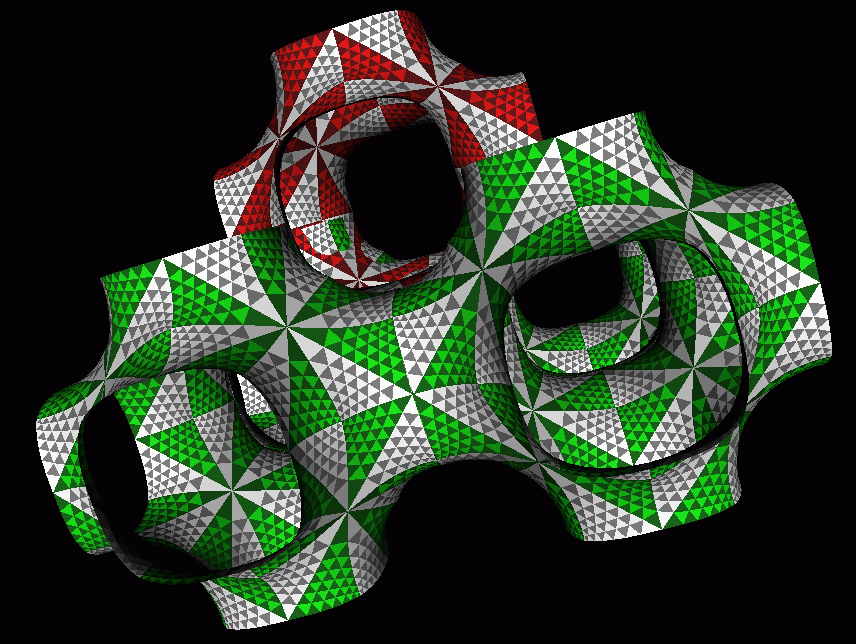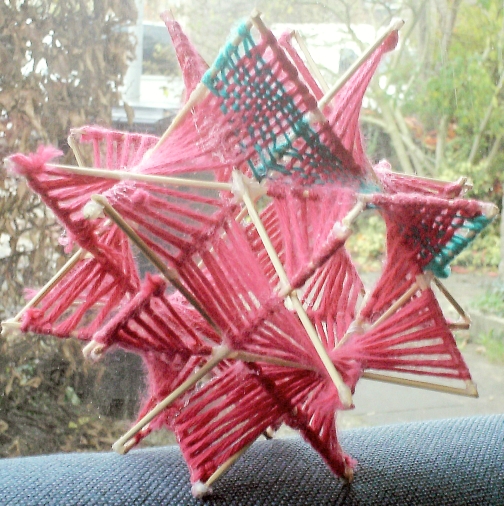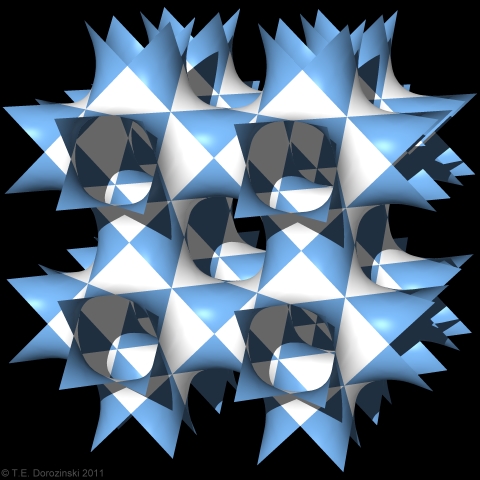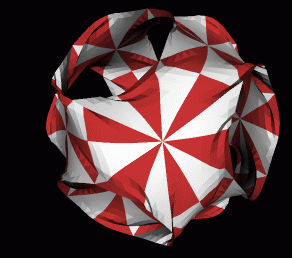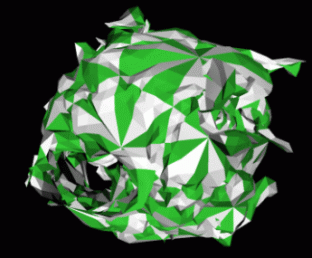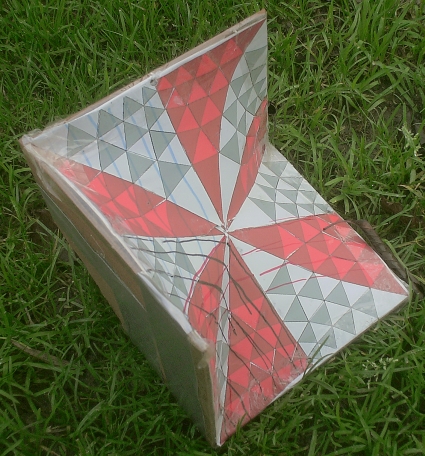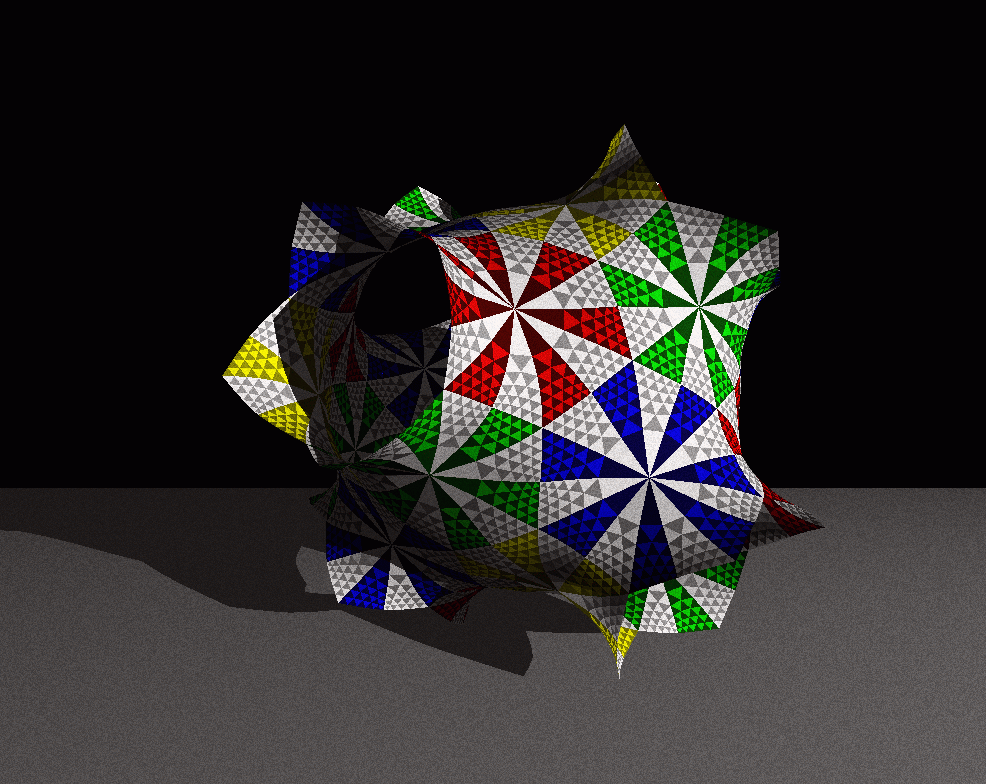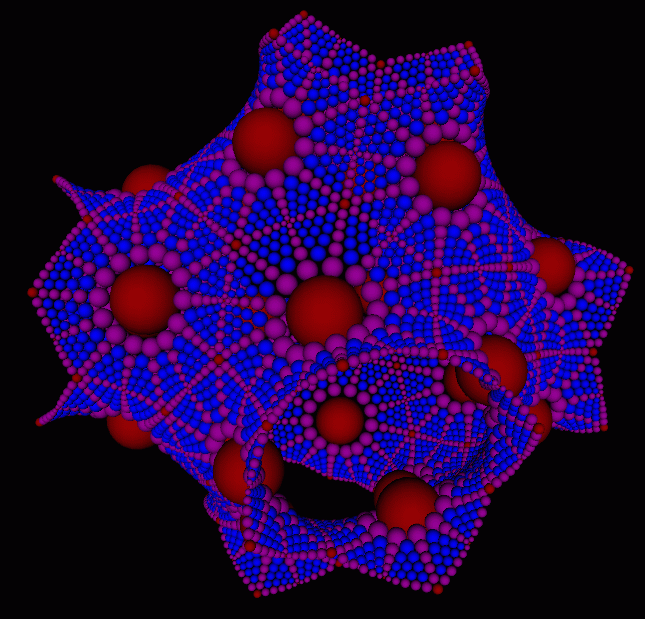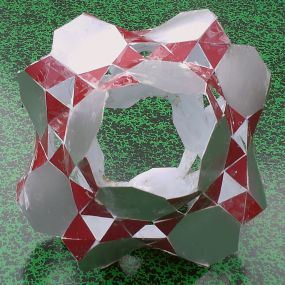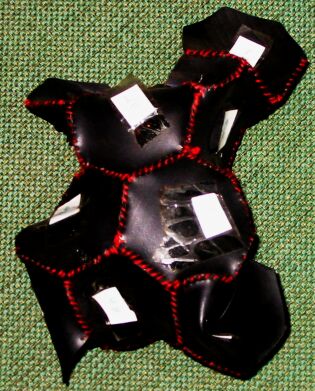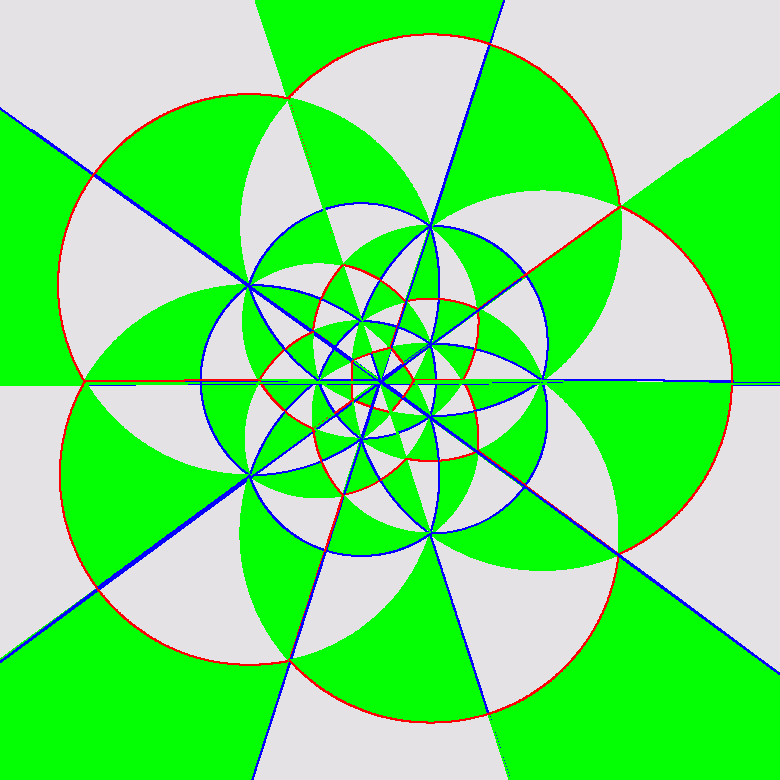Platonic
tilings of Riemann surfaces

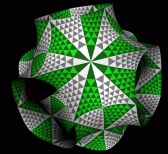
Introduction
I hate gluing together cardboard. And yet my house is full of
polyhedra,
pop-up cards and packaging concepts. Actually, I don't really hate
gluing,
but I always have too little time too work out ideas, and being in the
middle
of a sticky mess is one way of being reminded of this. There must be
something
good about it all.
This page is about some of the things I learned along the way, and
which
are not already covered in too many other web sites. One central theme
that
seems to be connected to all of it in many unexpected ways is:
"Platonic tilings of Riemann surfaces", the new title of this page.
(Tilings are also often called tessellations,
something to consider when searching the web)
A number of subjects all come together here:
-Polyhedra
-Complex functions
-Group Theory
-Riemann
surfaces
-Phase
Flow Plots
-Hyperbolic
tilings
-Mobius
transformations
-The
Modular Group
-Circle
packings
-Isometric
embeddings
We will need to talk about all of them, and see the big picture at the
end. We have lots of pretty pictures on the way.
This story should start with polyhedra. But there are already many
beautiful web sites on this, you might start here:
Pavilion
of Polyhedriality
If you want to learn about higher dimensional geometry, and its
relation to the universe, this is the best place:
John
Baez
Cool animations:
Greg
Egan
Tony
Smith
Other stuff by me:
Home
Nevertheless, I recently made some raytraced polyhedra
pictures myself. Click here
for more.
Symmetries?
Next we need to look at symmetries of the complex plane.
We could try complex functions, and see if they generate symmetry.
For example let's try:
f(z) = z2
+ c
Iterations of this function produce beautiful patterns: Fractals! The
first mapping that comes to mind appears to lead to an entirely
different subject. But because fractals turn out ultimately related to
tilings, check out the
images below.
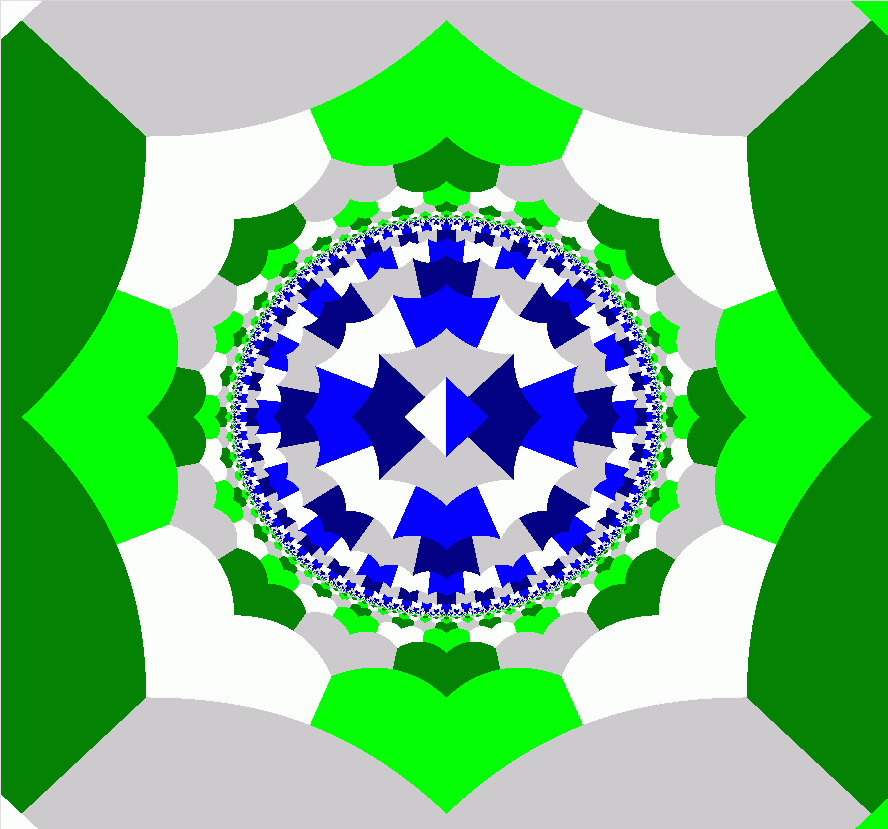 Tiles generated by the map z->z2
Tiles generated by the map z->z2
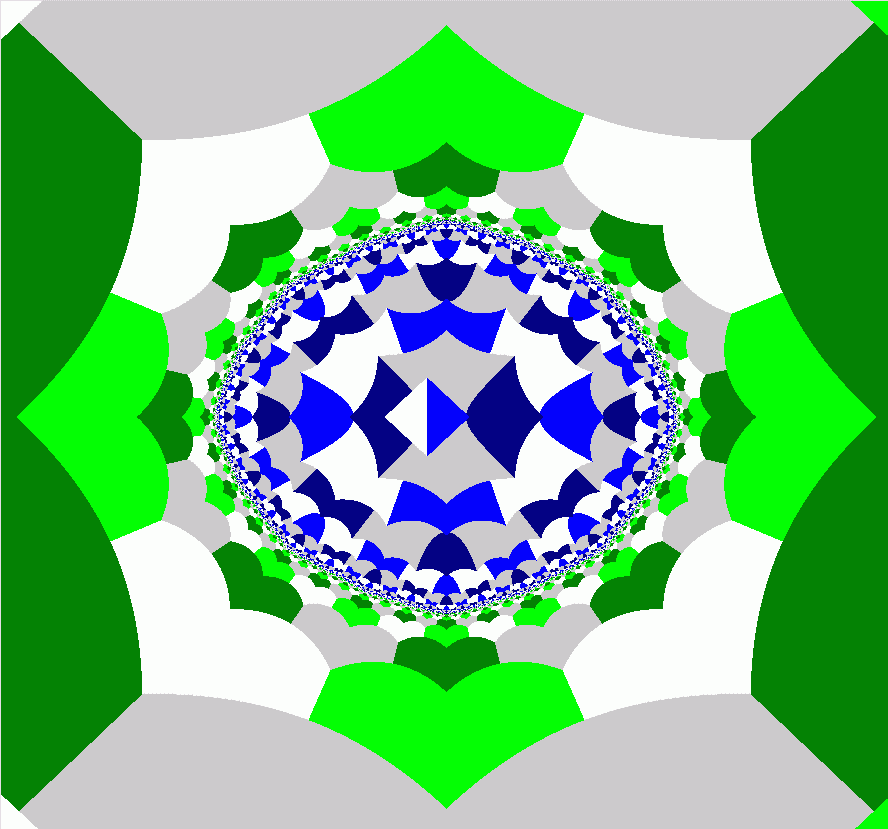
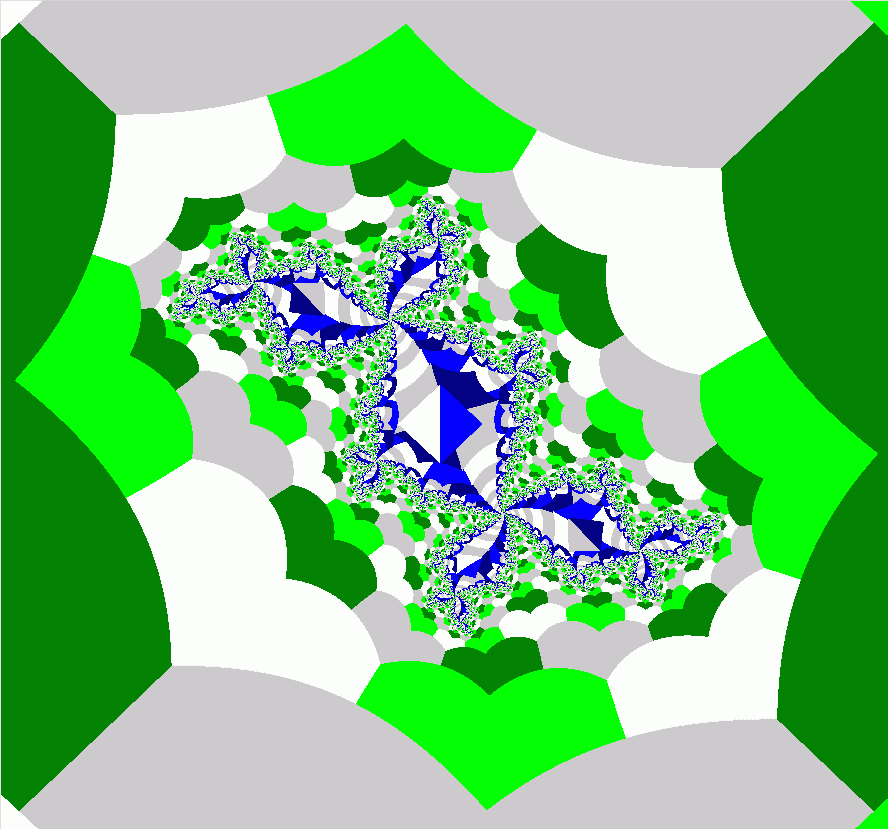
(click to enlarge)
Tiles generated by the maps z->z2 -0.1
and z->z2 -0.1+
0.75i
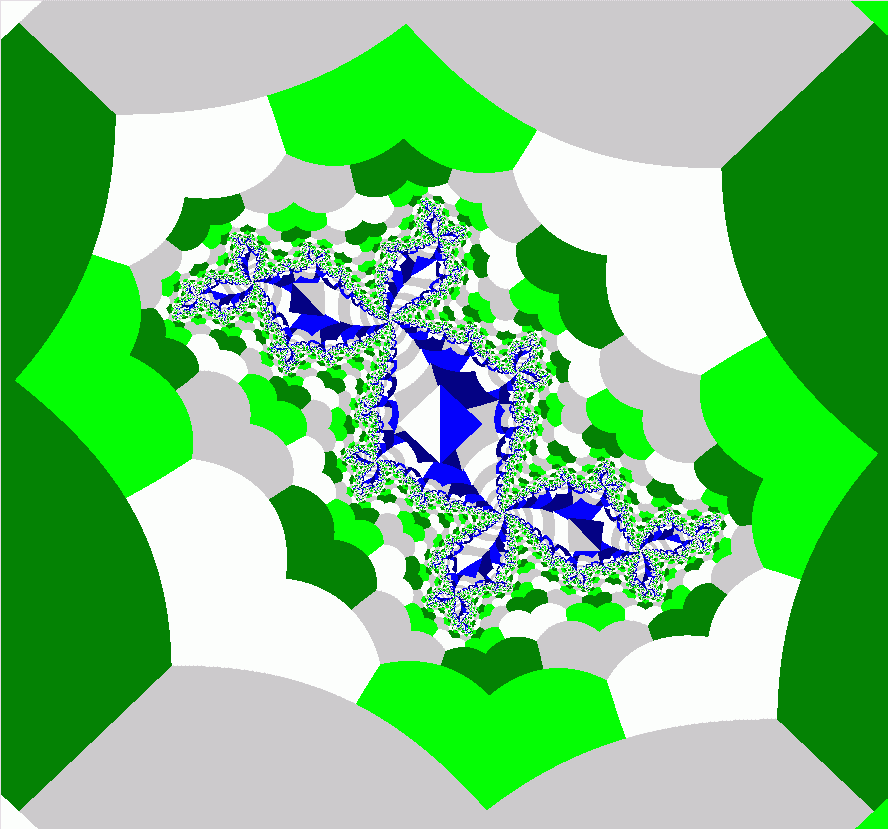 (Extra
picture for search engine related reasons)
(Extra
picture for search engine related reasons)
The images show regions of the complex plane depicted as colored tiles.
The complex function sends each of these tiles to a tile of the same
color, in such a way that each point of the complex plane is covered
exactly once.To make sure the tiles do not overlap or leave gaps, we
need to choosing a very specific tile as a starting point,
called
a fundamental
region.
(The fundamental region is not unique) In the case of the above
fractals, the algorithm for the tiling uses inverse
mapping: Each pixel is inverse iterated until its iterate ends up in a
fundamental region. Then it is given the color of that part of the
fundamental
region. For artistic reasons, we split the fundamental region up into 8
parts with 8 different colors. But 2 parts would have worked too: One
on the inside of the Julia set, one on the outside.
But there is a subtlety here: The complex function used is not a 1-to1
map: The inverse of the complex square, the complex square
root, is 2-valued. So the iterations of this maps do not form a group.
Specifically, this
means that the inverse map for each tile leads to 2 tiles instead of 1.
In a separate page, I look at fractional
iteration of fractals 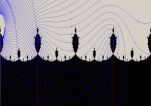 .
It is shown that fractal-generating maps can be made into a group by
choosing a suitable Riemann surface to plot them on. We will look first
at
tilings that correspond to symmetry groups, and we get back to fractals
later.
.
It is shown that fractal-generating maps can be made into a group by
choosing a suitable Riemann surface to plot them on. We will look first
at
tilings that correspond to symmetry groups, and we get back to fractals
later.
Mobius
transformations
To qualify as a group, a complex function must be single valued
and invertible. The only functions that are OK, turn out to be those
known as
Mobius transformations:
z-> (az+b)/(cz+d)
The first of their many surprising properties is that Mobius
transformations are a representation of the group of 2X2 matrices
( a b )
( c d )
But a subgroup of this is SU(2), which is closely related to
3-dimensional
rotations, as we know from quantum mechanics. And 3 dimensional
rotations have as beautiful subgroups, which we know as
the 5 Platonic solids: the tetrahedron, the cube, the octahedron the
dodecahedron
and the icosahedron.
Click here for a is a nice animation
film on Mobius transformations.
So to get our first finite group of transformations of the complex
plane,
we take the Platonics, find their representations in terms of SU(2)
matrices,
and turn these into Mobius transformations.
This allows us to make pictures:
\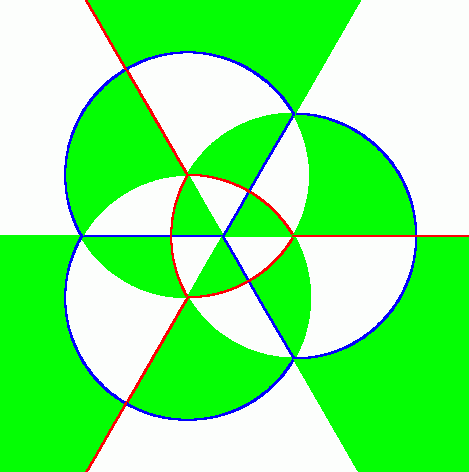
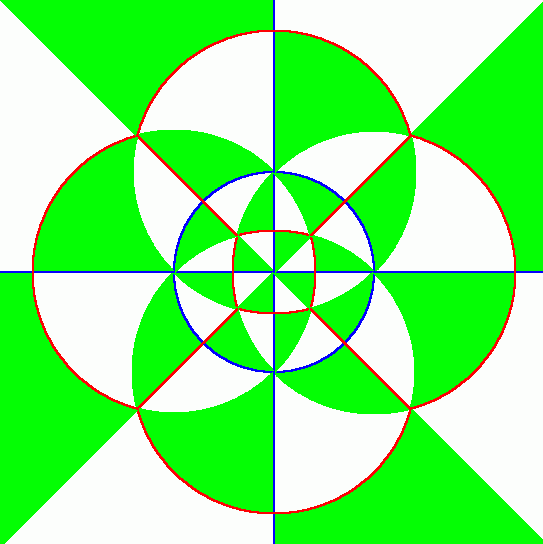 The tetrahedral tiling and the cubic/octahedral tiling
The tetrahedral tiling and the cubic/octahedral tiling
Below is a picture of how a tiling on the complex plane is turned into
a tiling of the Riemann sphere,
by a stereographic
projection
. A stereographic projection can be thought of as the effect of a light
on
the North pole shining through a semi transparent sphere onto a plane.
If
the plane is the complex plane, then the sphere is the Riemann sphere.
This
is one way of defining the Riemann sphere. The cool thing about the
Riemann
sphere is that infinity becomes a single point: the North pole. It is a
compactification of
the complex plane. On the
Riemann sphere, the Platonic symmetry of elliptic tilings is more
clearly visible.
There is a nice movie
on Youtube about Mobius transforms and stereographic projections.
If you consider a straight line as a circle of infinite radius, then
the
pictures can be thought of of being constructed entirely with circles.
Mobius
transformations turn circles into circles. The colored patches can also
be
viewed as polygons. If you look closely, you will notice that all
angles
at which the edges branch from the vertices are nicely 360/n. This is
initially
not so apparent because the edges are curved. Look at the polygons
formed
by the red lines. In the tetrahedral tiling, the red lines demark
polygons
with 3 sides (triangles), and 3 of them meet in each vertex, just like
in
an ordinary tetrahedron. Although they are different in shape, the angles
are all the same. In fact the
shape differences are caused by
our choice of coordinates, not by any internal asymmetry.
The blue lines demark the dual of the red tiling. If the red tilings
are
p-gons and the blue lines are q-gons we can describe the tiling using
the
Schlaefli symbol
(p,q). In this article, we will use
a slight variation on the Schlaefli
symbol, and
write (p,q,2). The colored patches of a (p,q,2) tiling have angles
(π/p, π/q, π/2).
So the above 2 examples are
(3,3,2) and (4,3,2).
The angles of A triangle in flat space always add up to 180
degrees, so
if
(1/p+1/q+1/2) = 1, we have a tiling of flat space. This is called a parabolic
tiling. If (1/p+1/q+1/2) < 1, the tiling is called elliptic,
and if (1/p+1/q+1/2) > 1, the tiling is called hyperbolic.
Note: In elliptic tilings, we consider infinity as a single point, so
we are in effect on the Riemann sphere. So all colored
patches are triangles, also the ones that protrude out of the picture
towards
infinity.
One last property before the next pictures: All lines are geodesics in
their respective curved spaces.
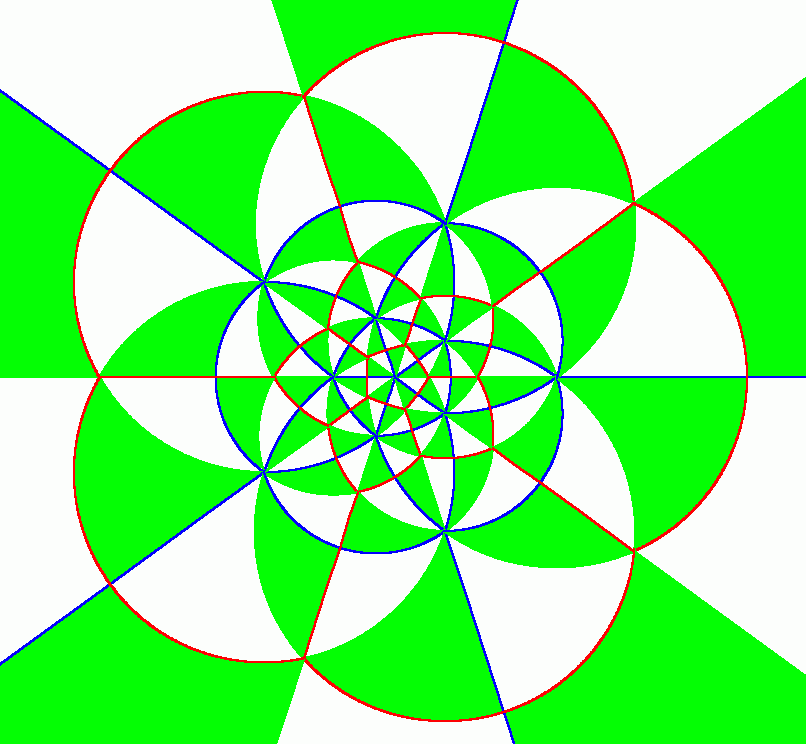
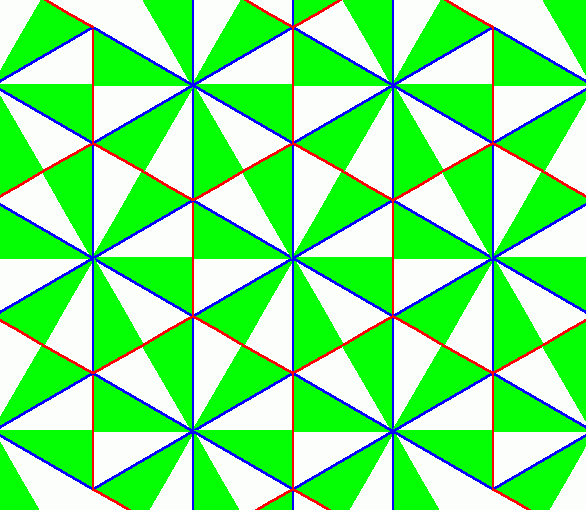
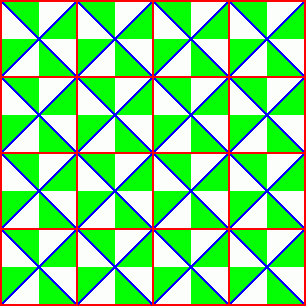 The dodecahedral/icosahedral tiling (5,3,2), the honeycomb (6,3,2) and
the
checkerboard (4,4,2).
The dodecahedral/icosahedral tiling (5,3,2), the honeycomb (6,3,2) and
the
checkerboard (4,4,2).
 (Extra
picture for search engine related reasons)
(Extra
picture for search engine related reasons)
The honeycomb is parabolic (flat).
Below are the elliptic tilings (2,3,2) and (2,2,2) and (2,1,2). These
can
also be viewed as
Platonic solids, but we don't always recognize a 2-gon ('digon) as a
polygon.
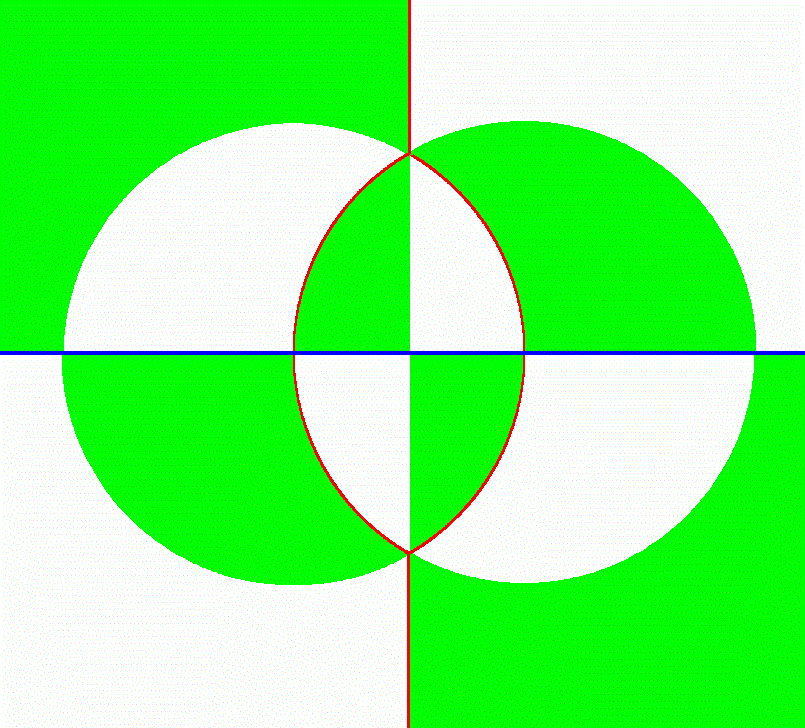
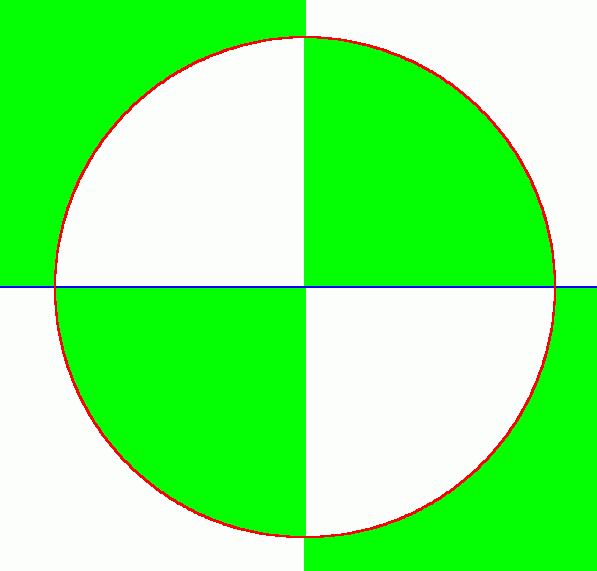
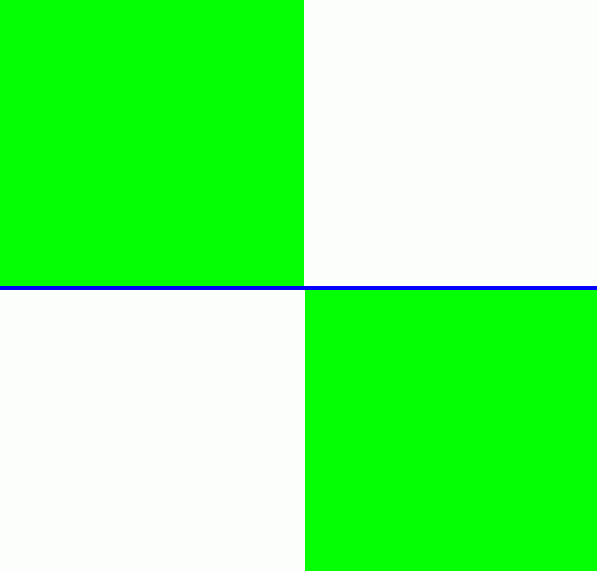 The (2,3,2), (2,2,2) and (2,1,2) tilings
The (2,3,2), (2,2,2) and (2,1,2) tilings
You can choose any adjacent pair of green/white patches as a fundamental
region of the group:
All points on the complex plane are a unique image of a point of the
fundamental
region. This is in fact how I make these pictures. I figure
out half of a fundamental region, color it green, and then transform it
into lots of copies, using
2 generators of the group, until I cover the whole plane. "Lots" of
copies?
The amount of copies is of course exactly equal to the order of the
group.
Each tile also corresponds to a tile on a Platonic solid, by
stereographic projection as illustrated by earlier graphics.
Wallpaper
groups
There are 17 "Wallpaper groups", or symmetries of the Euclidean
plane. They are all subgroups of the (6,3,2) and (4,4,2) tilings we
already described. One
way to describe subgroups, is to use coloring on the "parent" tiling.
We count 2 tiles as "the same" if both their shape and color are the
same. By painting patterns on the parent tiling, we can get a tiling
that is no longer invariant under the original symmetry group, but
still is under a subgroup. The fundamental domain for these subgroups
will be a tile that consists of a number of fundamental domains of the
parent tiling.
Below, the 17 possibilities are listed. They are described in the nice
book The
Symmetries of Things. This book
should definitely be on your
shelf if you like this web page. The classification is done by orbifold
notation.
Fundamental domains are outlined in black. Note that the fundamental
domain is not unique, for each case we could have chosen another one,
or indeed another pattern with the same symmetry class.
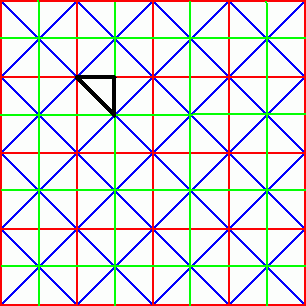
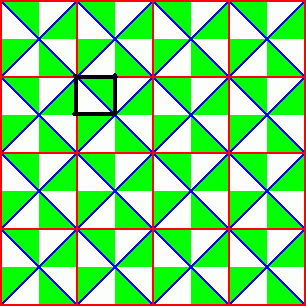
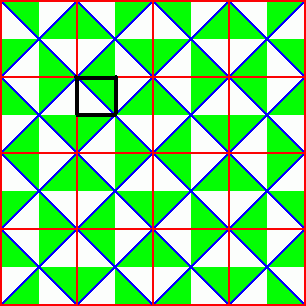
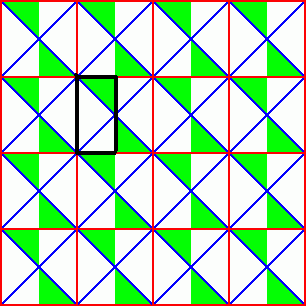
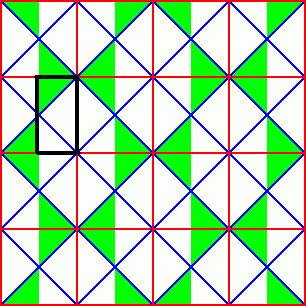 *422
422
4*2
2222
2*22
*422
422
4*2
2222
2*22
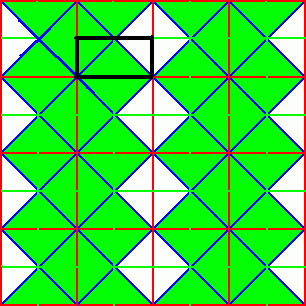
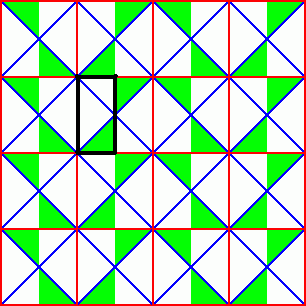
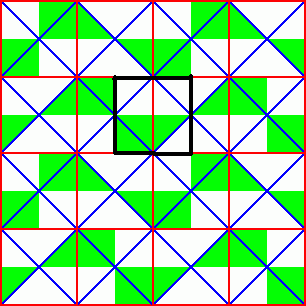
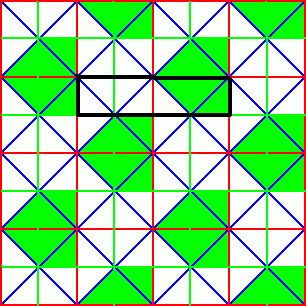
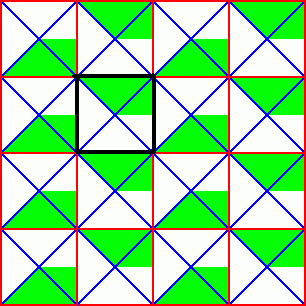 *2222
22*
22X
*X
XX
*2222
22*
22X
*X
XX
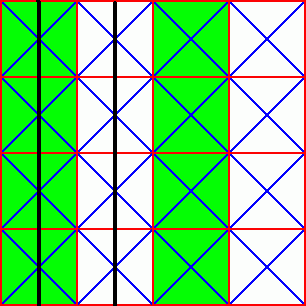
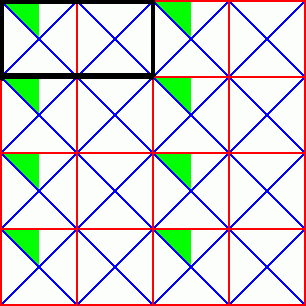
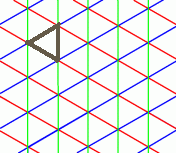 **
O
*333
**
O
*333
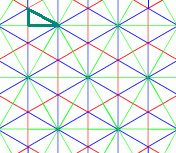
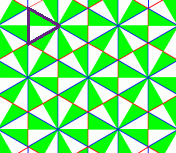
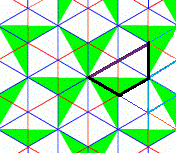
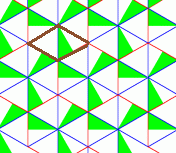 *632
632
3*3
333
*632
632
3*3
333
Hyperbolic
tilings
So far, we have just portrayed the Platonics in an unfamiliar way. But
now
we will do a trick that is easy with Mobius transformations, but
difficult
without. All pictures so far are made with 2 generators that are cyclic
with
order 2 and p. p=3 gives the tetrahedron, p=4 the cube, p=5 the
dodecahedron,
and
p=6 the honeycomb. and lets not forget little p=2. The 2 generators
have the property that their product has order 3, related to that they
have Schlaefli symbol (p,3,2)
But for p>6, life gets a bit hard in ordinary space, because a
vertex
of 3 heptagons doesn't fit in 360 degrees. That is why there is no
Platonic
solid with heptagons. But with Mobius transformations, we can go
further!
We take 2 cyclic generators of order 7, chosen so that their product is
of
order 3. We then do the same trick, and get the following pictures:
(The
second one is with p=8)
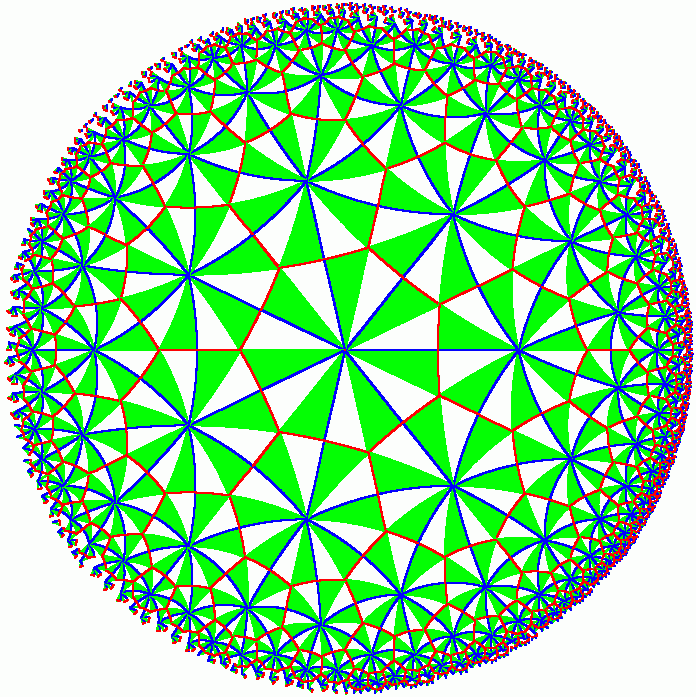
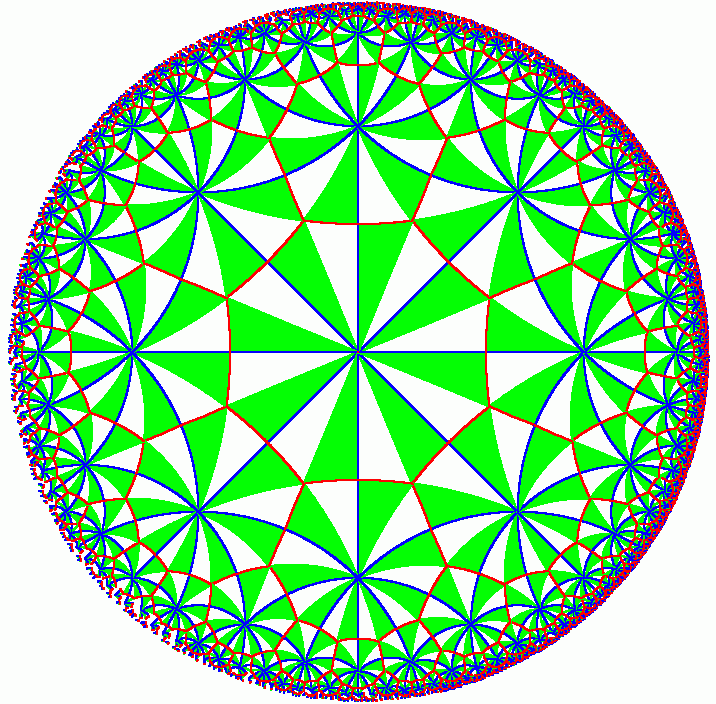 (7,3,2) and (8,3,2) hyperbolic tilings.
(7,3,2) and (8,3,2) hyperbolic tilings.
The hyperbolic tilings have infinitely many tiles. An intriguing
property
is that our 2 generators never map out of the disk that we see in the
last 2 pictures. This disk is called the Poincaré
disk.
It has all kinds of
properties, but we get it for free by just iterating 2 Mobius
transformations.
We could also tile outside of the disk, but we need a second
fundamental
region, one outside instead of inside the Poincaré disk.
So what have we got so far? We have the well known Platonic polyhedra
as tilings,
the planar tilings and the hyperbolic tilings with their infinitely
many
tiles. So is there more? Yes! Reading Coxeters book "Complex regular
polytopes",
I came to understand that  every
group that is presented by 2
generators, corresponds to a
tiling of a Riemann surface. To
see this we use a
very
nice way of constructing a "Cayley graph" of an arbitrary group
presented
by 2 generators. This method is used by Coxeter for the honeycombed
tiling,
and he remarks that it can be used for other tilings too. A Cayley
graph
shows the structure of a group by presenting its elements as vertices,
and
using color arrowed edges to represent which elements are mapped onto
each
other by generators. Each generator has a separate color. One thing you
can
do with a Cayley graph, is read of how to get from one element to
another
using generators. Just draw a path, and read off the generators from
each
edge. The resulting string of generators is called a "word".
All words
can be visualized using the Cayley graph. Suppose we have 2 cyclic
generators
Ap
= Bq
=1. Let C = (AB)-1,
so that ABC=1. C is also cyclic, Cr
=1. We can
now construct a planar Cayley graph, such as the one below, which is
for the tetrahedral group, for which A3
= B3
= C2
= 1.
every
group that is presented by 2
generators, corresponds to a
tiling of a Riemann surface. To
see this we use a
very
nice way of constructing a "Cayley graph" of an arbitrary group
presented
by 2 generators. This method is used by Coxeter for the honeycombed
tiling,
and he remarks that it can be used for other tilings too. A Cayley
graph
shows the structure of a group by presenting its elements as vertices,
and
using color arrowed edges to represent which elements are mapped onto
each
other by generators. Each generator has a separate color. One thing you
can
do with a Cayley graph, is read of how to get from one element to
another
using generators. Just draw a path, and read off the generators from
each
edge. The resulting string of generators is called a "word".
All words
can be visualized using the Cayley graph. Suppose we have 2 cyclic
generators
Ap
= Bq
=1. Let C = (AB)-1,
so that ABC=1. C is also cyclic, Cr
=1. We can
now construct a planar Cayley graph, such as the one below, which is
for the tetrahedral group, for which A3
= B3
= C2
= 1.
We call C a generator, although it is actually dependent on A and B.
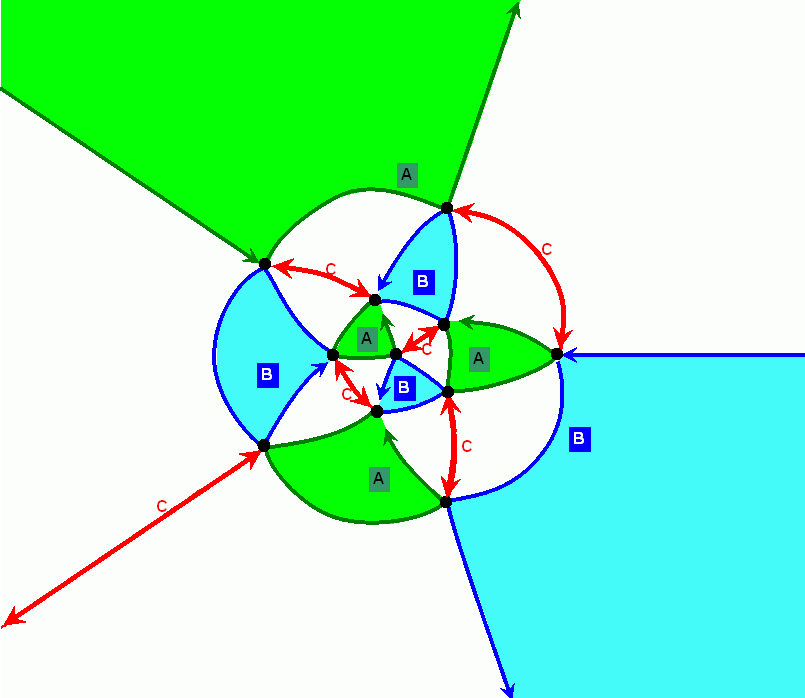
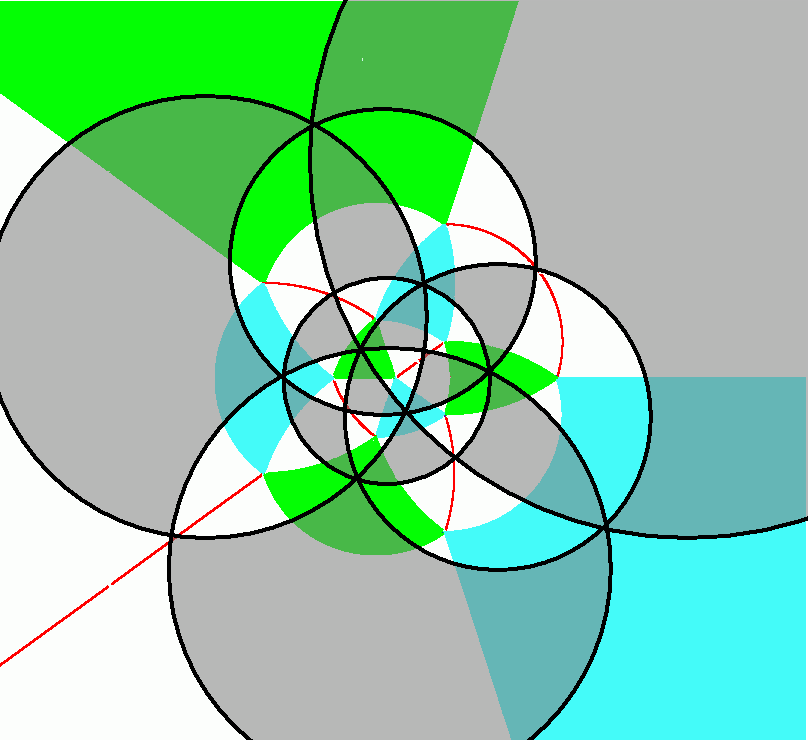 A planar Cayley graph
of the tetrahedral group. Similar "2-dimensional"
Cayley graphs can be constructed for all tilings. These Cayley graphs
are themselves a (p,q,r) tiling. The picture on the right illustrates
how you can reconstruct the tetrahedral tiling from the Cayley-graph:
It is the dual of the (p,q,r) tiling.
A planar Cayley graph
of the tetrahedral group. Similar "2-dimensional"
Cayley graphs can be constructed for all tilings. These Cayley graphs
are themselves a (p,q,r) tiling. The picture on the right illustrates
how you can reconstruct the tetrahedral tiling from the Cayley-graph:
It is the dual of the (p,q,r) tiling.
The above Cayley graph has the following properties:
-Each vertex has 6 edges connected. An arrow of each color leaves each
vertex once and arrives there once.
-The arrows labeled A enclose a p-gon, in this case p =3
-The arrows labeled B enclose a q-gon, in this case q =3
-The arrows labeled C enclose a r-gon, in this case r =2, a "digon"
which
degenerated to a bidirectional arrow. But the red bidirectional arrows
could
also have been polygons, in case r>2.
-The p, q and r gons are never adjacent, but always have a white
triangle
in between them. The white triangles encode the relation ABC=1, as can
be
read of from the Cayley graph.
-In general, we can construct a "planar" Cayley graph, which has the
Archimedean tiling (p,3,q,3,r,3).
In general, a planar Cayley graph constructed this way is Archimedean,
but
in the case of the tetrahedral group the tiling is Platonic, because
the
"snub tetrahedron": happens to coincide with the icosahedron, with its
12
vertices.
The Cayley graph itself is already an Archimedean tiling., but from it
we can construct a Platonic tiling corresponding to the group in
question. For every node of the Cayley graph there is precisely one
group element. Around each element there is a p-gon, q-gon and an
r-gon, separated by 3 triangles. Connect a point in the p-gon,
q-gon and an r-gon, to form a triangle around the group element. This
triangle is a fundamental region for a tiling that has the group in
question as its symmetry group. The right hand picture shows the result.
So now we can go on to find more tilings, by traveling through
group-land and looking for groups presented by 2 generators. Below is a
less obvious tiling, of the group presented by the generators:
1=A5
=B4=(AB)3
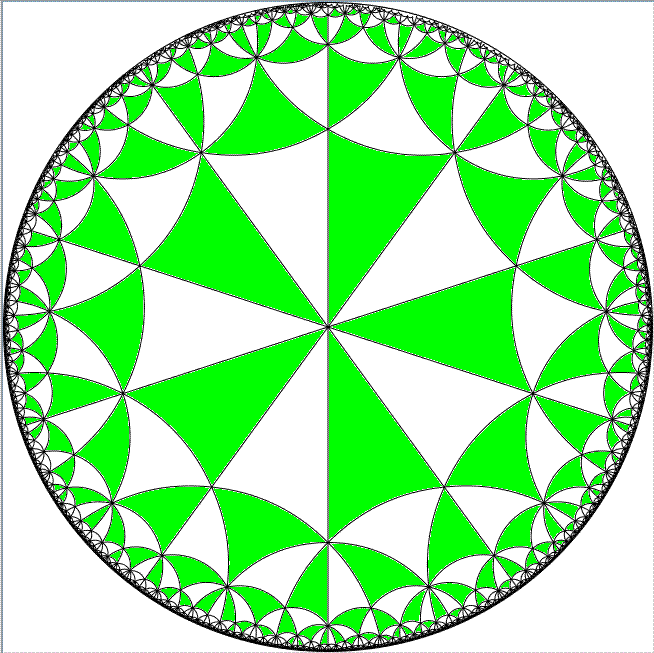 Tiling
with symmetry
group presented by 1=A5 =B4=(AB)3
(This
picture was
created using the freeware program 'qt4Tess'.)
Tiling
with symmetry
group presented by 1=A5 =B4=(AB)3
(This
picture was
created using the freeware program 'qt4Tess'.)
This tiling does not have a Schlaefli symbol, because the
triangles do not form p-gons or q-gons. This would have been the case
if one of our generators had period 2. But if we write an "ordinary"
Schlaefli symbol (p,q) as (p,q,2), we could write this one as (5,4,3).
(Or, we couls use orbifold
notation, and write 543, or
*543/543)
The
modular group
Many groups are quotient groups of the Modular
group
. This is an incredibly cool group that is important in number theory.
Perhaps
my favorite property of the modular group is that I can generate it
with
2 Mobius transformations:
A:
z-> z+1 (a translation)
B:
z-> -1/z (inversion in the unit circle)
This property enables us to make a picture of it using the same
software that I already made for the other pictures:
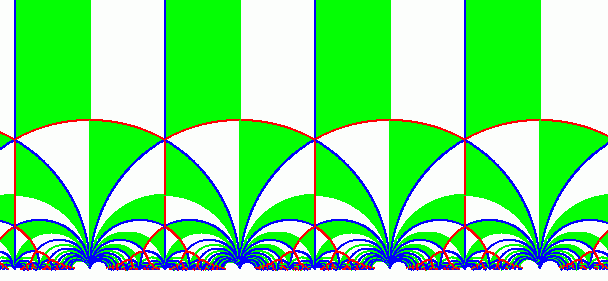 The modular group.
The modular group.
The matrices of the modular group are composed of 4 integers:

The determinant is 1.
 The intersections of the modular tiling with the real axis are
exactly all the rational
numbers! I got that from the
book 'Indra's
Pearls'. This book is quite
related to this web page, so if
you like this page, you might want to read it.
The intersections of the modular tiling with the real axis are
exactly all the rational
numbers! I got that from the
book 'Indra's
Pearls'. This book is quite
related to this web page, so if
you like this page, you might want to read it.
Furthermore, there is a structure that relates the matrices of a
triangle in the modular to the rational number is are located its
vertex on the real axis. Below is a picture of this.
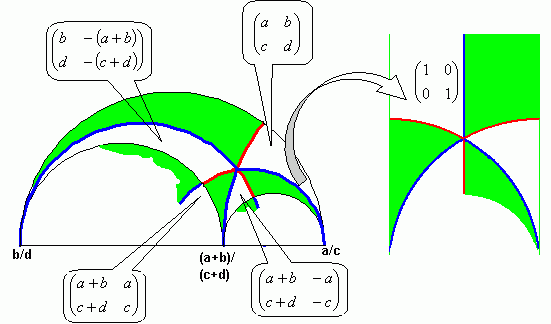 The
relation of a
triangle with
vertices {a/b, c/d, (a+b)/(c+d)} to matrices that
map its
sub-triangles to the fundamental domain.
The
relation of a
triangle with
vertices {a/b, c/d, (a+b)/(c+d)} to matrices that
map its
sub-triangles to the fundamental domain.
Note that the middle vertex
is a function of the 2 outer
vertices. Using this relation, you can construct the Stern
Brocot tree, a scheme that lists
each rational number exactly
once:
 (Wikipedia
image): Part
of the Stern Brocot Tree
(Wikipedia
image): Part
of the Stern Brocot Tree
Note that infinity in the
form of 1/0 is also used as a
fraction.
 The stern brocot tree gives a 1-to-1 correspondence between the
rationals and binary strings. If left is '0' and right is '1', then you
can represent any rational by the driving instruction to get to it in
the Stern Brocot tree. For example, the number 3/4 would be '011',
while 4 would be '111'.
The stern brocot tree gives a 1-to-1 correspondence between the
rationals and binary strings. If left is '0' and right is '1', then you
can represent any rational by the driving instruction to get to it in
the Stern Brocot tree. For example, the number 3/4 would be '011',
while 4 would be '111'.
There is a discussion
about this on the web log 'n category cafe'.
There is an interesting relation to the golden ratio, the "most
irratrional number". This would have "Farey adres '1010101010101.....'
as shown below
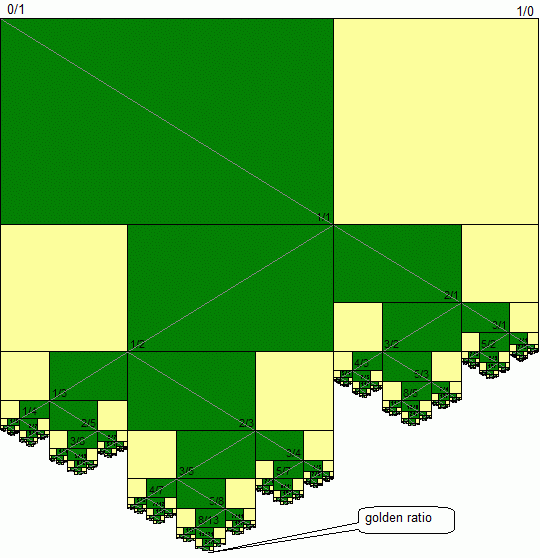 The
golden ratio has Farey adres
'1010101010101.....'
The
golden ratio has Farey adres
'1010101010101.....'
You
get fractions composed of consequetive
Fibonacci numbers, F(n+1)/F(n), which appraoches the Golden
ratio
as n->inf.
Another nice way the rational
numbers are hidden inside
the modular tiling is through Ford
circles.
All tilings on this page also have a Circle Packing:
A circle
can be placed in each polygon in such a way that the circle just
touches
the circles on all neighboring polygons. If you do this for the modular
tiling, you get Ford circles. Again, each rational number has exactly
one Ford circle.  The
radii of "kissing" circles are related by a
magical formula called the "kiss
precise".
The
radii of "kissing" circles are related by a
magical formula called the "kiss
precise".
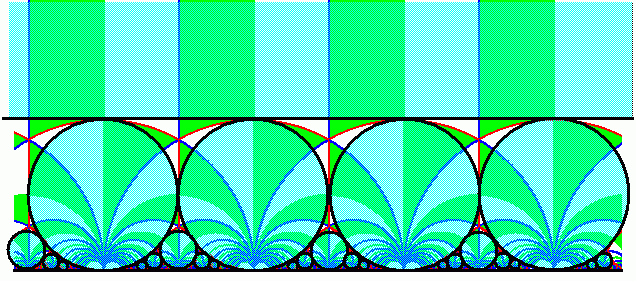 Ford
circles. Each
rational number
has a circle associated with it, and the circles form an Appolonian
gasket, with all kinds of special properties.
Ford
circles. Each
rational number
has a circle associated with it, and the circles form an Appolonian
gasket, with all kinds of special properties.
On a separate
page, I discuss a generalisation
of the Modular group in which the 2X2 matrices have Gaussian integers
instead of real integers. This gives the Modular
Honeycombe:
Now let us see how other tilings are quotients of the modular group.
A quotient
tiling is a sub-tiling
that generates the parent
tiling (without overlap) if transformed by all elements of a subgroup
of
the parent symmetry.
If the subgroup is a "normal subgroup"(ie invariant under conjugation)
then the quotient tiling is Platonic.
There is one easy way to get smaller groups from the modular group:
Just
replace the integers in the transformation by integers modulo n.
(These groups
are quotient groups of the subgroups formed by matrices
congruent to identity modulo n.)
It turns out that these groups are very interesting.
The subgroup generated by just the inversion is isomorphic to
the (2,1,2) tiling (red triangles, N=2 )
The modulo 2 case is isomorphic to the (2,3,2) tiling (orange triangles
included, N=6 )
The modulo 3 case is isomorphic to the tetrahedral tiling (yellow
triangles included,
N=12)
The modulo 4 case is isomorphic to the cubic tiling
(green triangles
included, N=24)
The modulo 5 case is isomorphic to the icosahedral tiling (I stopped
drawing here, N=60)
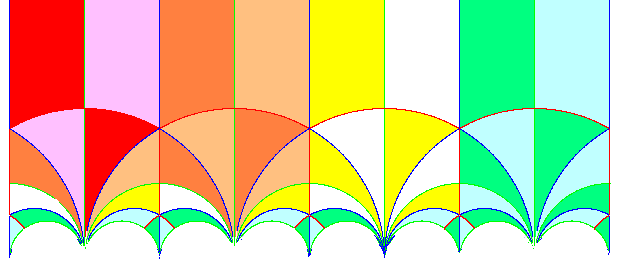 The
first quotient groups formed
from the modular group.
The
first quotient groups formed
from the modular group.
The subtilings of the modular tiling do not look immediately much like
Platonic solids. To further illustrate the connection, I made the
images below. These show "Hyperbolic" versions of Platonic solids; Each
(p,3,2) triangle in an "ordinary" Platonic replaced by a hyperbolic
(∞,3,2)
triangle in the hyperbolic version. All triangles in the modular
tessellation are
also (∞,3,2) triangles, so we have a conformal mapping
from the modular tessellation to the Hyperbolic Platonics. The zero
angle vertices meet in "cusps". To keep the image finite, I used an
angle of π/36
instead of zero. The
number of triangles is the same, and the
groups that transforms the triangles into each other are isomorphic. To
go from the hyperbolic Platonic to the flat or spherical version, we
can use Ricci
flow,
the technique used to prove the Poincaré
conjecture.  Ricci flow
sounds like heavy duty stuff, but discrete Ricci flow is simply
changing the sizes of the triangle in the triangulation so that the
local curvature "flows" to a prescribed value.
Ricci flow
sounds like heavy duty stuff, but discrete Ricci flow is simply
changing the sizes of the triangle in the triangulation so that the
local curvature "flows" to a prescribed value.
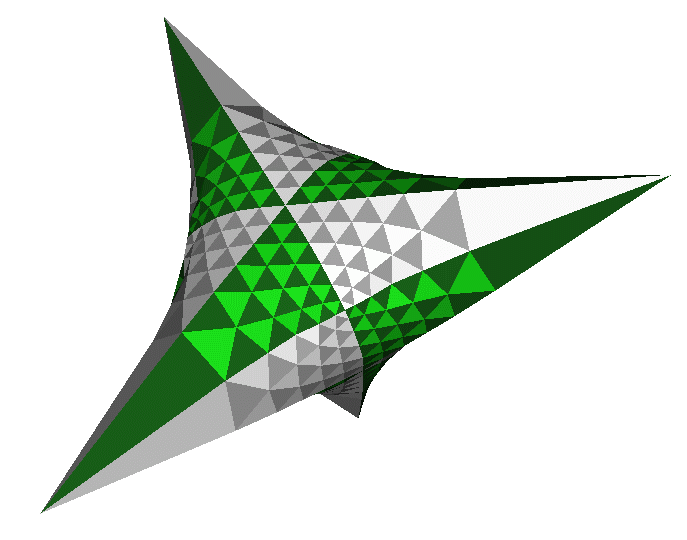
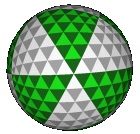
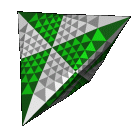 Hyperbolic,
spherical
and planar tetrahedron.
The
hyperbolic triangles are
Hyperbolic,
spherical
and planar tetrahedron.
The
hyperbolic triangles are π
/2, π
/3, and π
/∞ (approximated
by π
/36).
The spherical
triangles are π
/2, π
/3, π
/3.
The spherical flat
are π
/2, π
/6, π
/3.
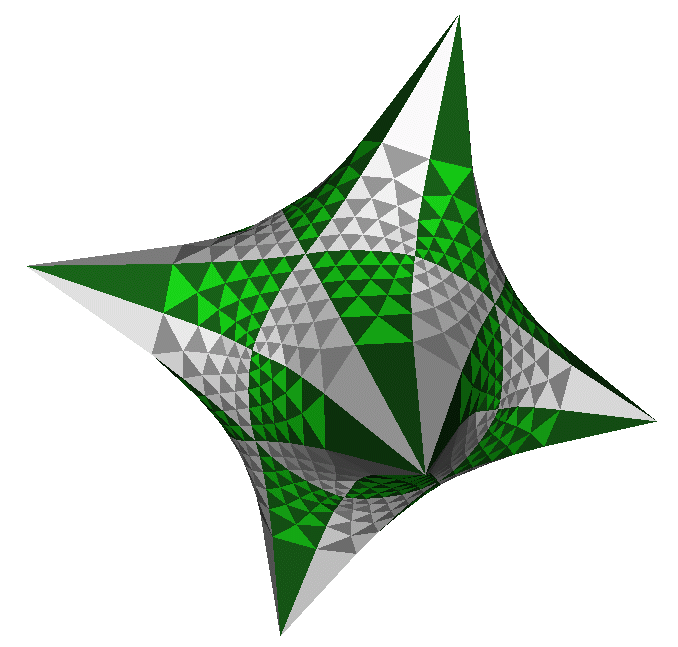
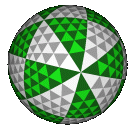
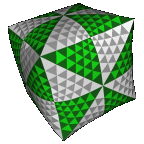 Hyperbolic, spherical and planar Cube.
The
hyperbolic triangles are
Hyperbolic, spherical and planar Cube.
The
hyperbolic triangles are π
/2, π
/3, and π
/∞ (approximated
by π
/36).
The spherical
triangles are π
/2, π
/3, π
/4.
The Planar triangles
are π
/2, π
/4, π
/4.
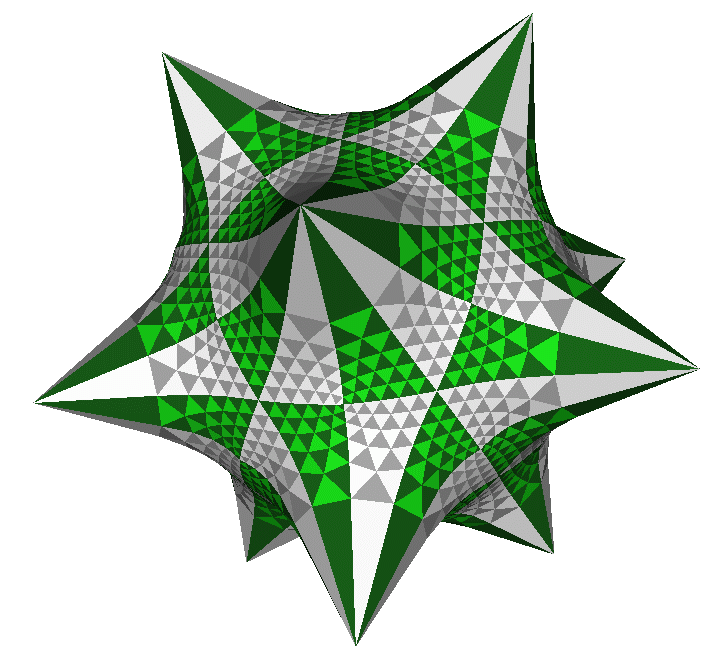
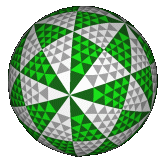
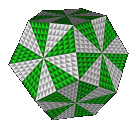 Click here for VMRL file
Click here for VMRL file
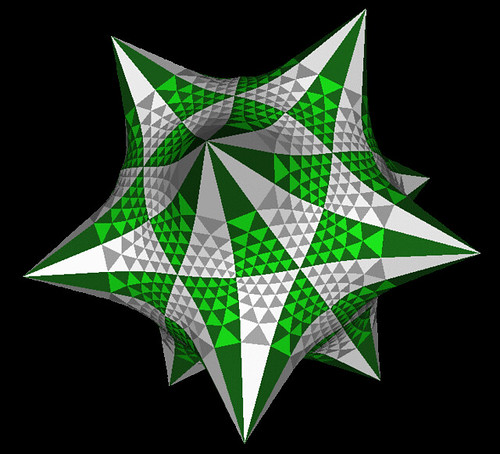 (Extra picture for search
engine related reasons)
Hyperbolic,
spherical and planar Dodecahedron.
The
hyperbolic triangles are
(Extra picture for search
engine related reasons)
Hyperbolic,
spherical and planar Dodecahedron.
The
hyperbolic triangles are π
/2, π
/3, and π
/∞ (approximated
by π
/36).
The spherical
triangles are π
/2, π
/3, π
/5.
The planar triangles
are π
/2, 2π
/5, π
/5.
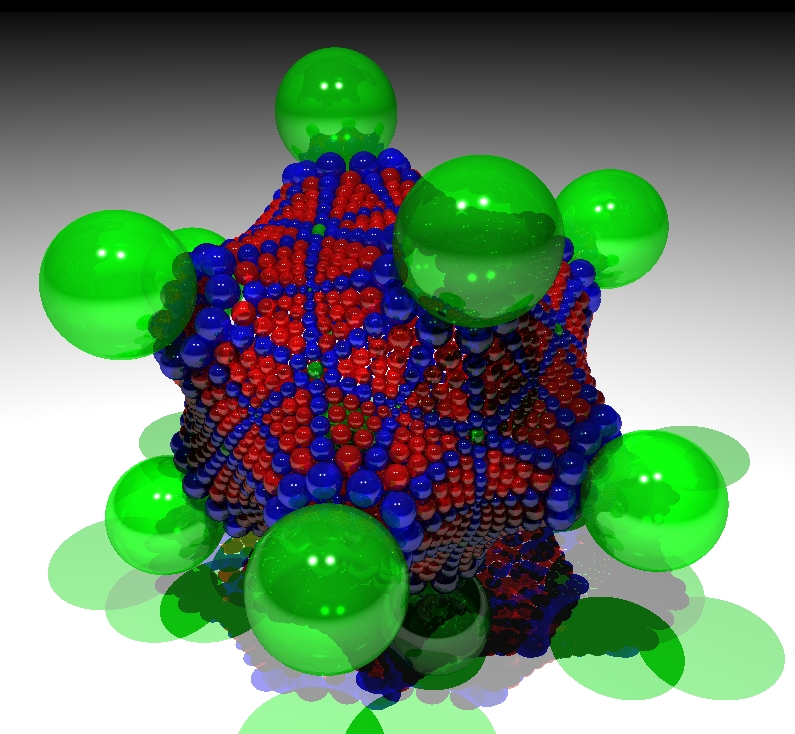 The
circle packing for
the hyperbolic dodecahedron, rendered with POVray, using glassy beads.
The
circle packing for
the hyperbolic dodecahedron, rendered with POVray, using glassy beads.
 My hyperbolic Platonics have constant
negative
Gaussian curvature everywhere
except at the cusps, where
the curvature is positive infinity. In this sense, thy are nicer than the
ones at the mathworld site. For
more on constant negative
Gaussian curvature, click here.
My hyperbolic Platonics have constant
negative
Gaussian curvature everywhere
except at the cusps, where
the curvature is positive infinity. In this sense, thy are nicer than the
ones at the mathworld site. For
more on constant negative
Gaussian curvature, click here.
A
cardboard model of the spherical dodecahedron:
The plaster models below are made by Walther von Dyck, a 19th century
German mathematician, who also discovered the Dyck tesselation of Fermat's quartic.
They
are from a photo
gallery of Groningen university.
So
far, up to modulo 5,
the the quotients of the modular tilings are
isomorphic
to
the well-known platonic polyhedra.
The number of triangles is the same, and the
groups that transforms the triangles into each other are
isomorphic.
But if we go modulo 6, something new happens: A (2,3,6) tiling, but not
the infinite honeycomb. This time, the tiling is finite. From the
Euler characteristic we know that we have a torus. Thus, we
get a
recipe for making a Platonic tiling on a Riemann surface of finite
genus.
Going further, the next quotient is a
(2,3,7) tiling. Many yeas earlier, Felix Klein was doing just this, and
that is how he discovered "Klein's quartic": A genus 3 surface tiled by
24 heptagons.
Again,
it is not so easy to visualize the
isomorphism. To aid this, I made the animation below.
I generated a slice of Gamma(7), by using reflections in the sides of
the triangles. Then I slowly turn the (∞, 3, 2) triangles
into
(7,3,2) triangles, but keep the topology the same because it remains
generated by reflections in the triangle sides.
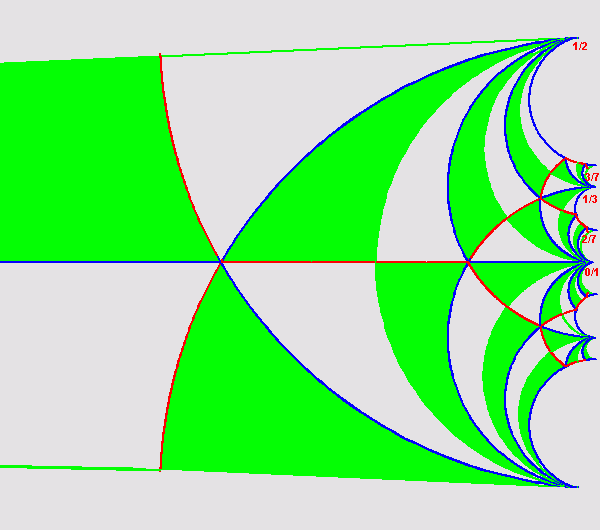 Animation
of a quotient of the modular tiling transforming into a (7,3,2) tiling.
Animation
of a quotient of the modular tiling transforming into a (7,3,2) tiling.
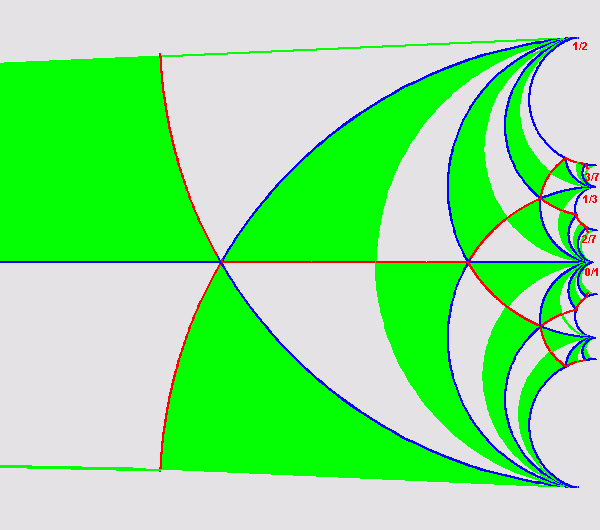 (Extra
picture for search engine related reasons)
(Extra
picture for search engine related reasons)
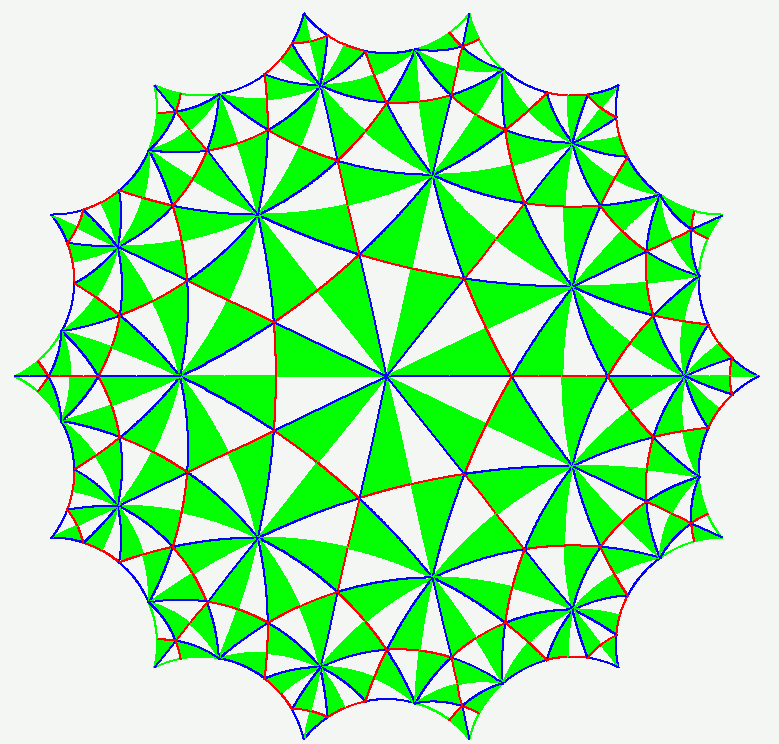
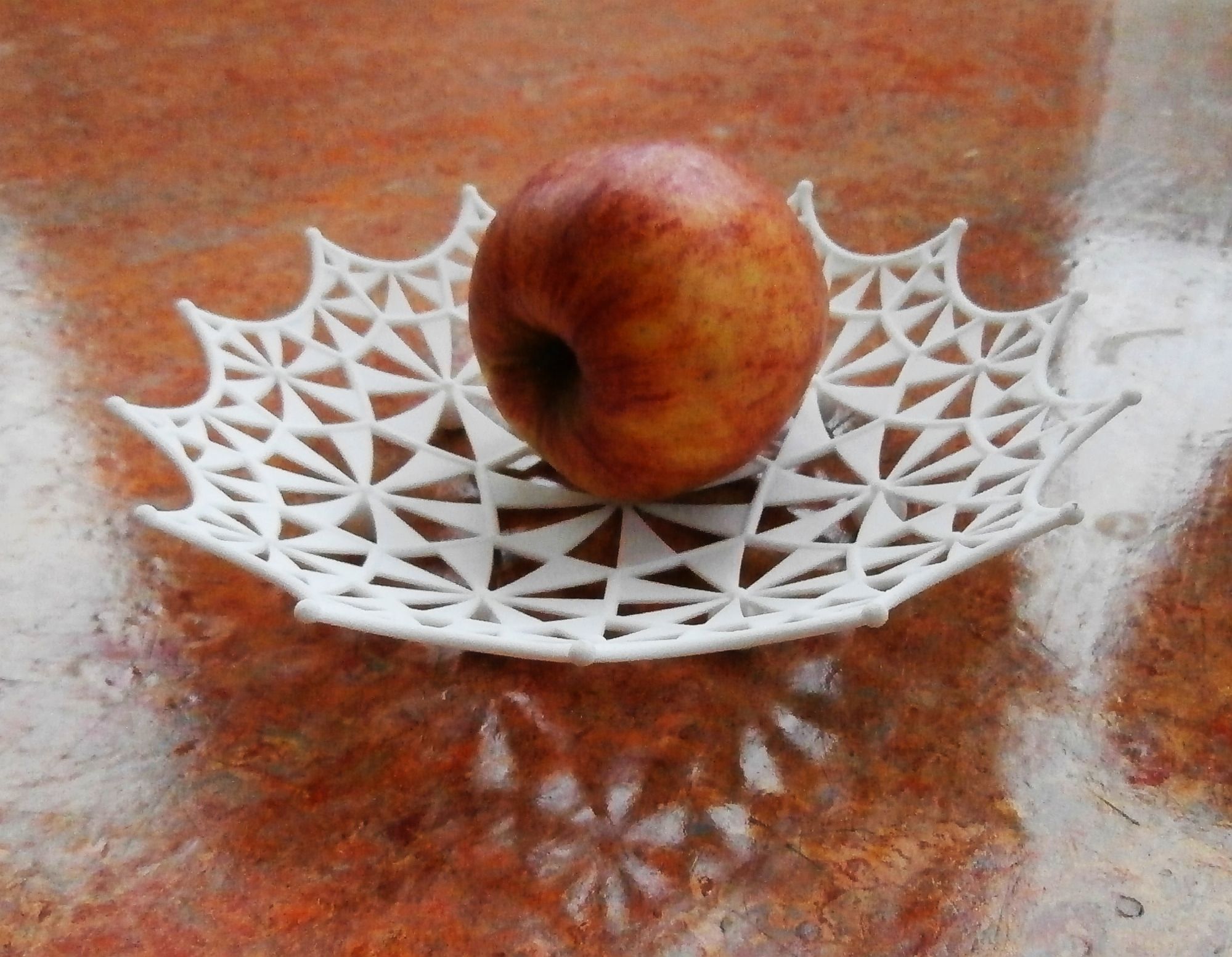 Fundamental
polygon for
Klein's quartic (To the right a 3D printed Fruit bowl I made)
Fundamental
polygon for
Klein's quartic (To the right a 3D printed Fruit bowl I made)
H. A.
Verrill
has a
nice online Java applet that computes fundamental domains of
Γ (the modular group), Γ0
and Γ1(2
modified versions of the modular group). Using this applet, I made a
table for p = 1 to p = 11. n is the order of the group, c is the number
of cusps, and g is the genus.
|
Γ |
|
|
Γ0 |
|
|
Γ1 |
|
|
|
| p |
n |
c |
g |
n |
c |
g |
n |
c |
g |
|
| 1 |
1 |
1 |
0 |
1 |
1 |
0 |
1 |
1 |
0 |
|
| 2 |
6 |
3 |
0 |
3 |
2 |
0 |
3 |
2 |
0 |
|
| 3 |
12 |
4 |
0 |
4 |
2 |
0 |
4 |
2 |
0 |
|
| 4 |
24 |
6 |
0 |
6 |
3 |
0 |
6 |
3 |
0 |
|
| 5 |
60 |
12 |
0 |
6 |
2 |
0 |
12 |
4 |
0 |
|
| 6 |
72 |
12 |
1 |
12 |
4 |
0 |
12 |
4 |
0 |
|
| 7 |
168 |
24 |
3 |
8 |
2 |
0 |
24 |
6 |
0 |
|
| 8 |
192 |
24 |
5 |
12 |
4 |
0 |
24 |
6 |
0 |
|
| 9 |
324 |
36 |
10 |
12 |
4 |
0 |
36 |
6 |
0 |
|
| 10 |
360 |
36 |
13 |
18 |
4 |
0 |
36 |
8 |
0 |
|
| 11 |
660 |
60 |
26 |
12 |
2 |
1 |
60 |
10 |
1 |
|
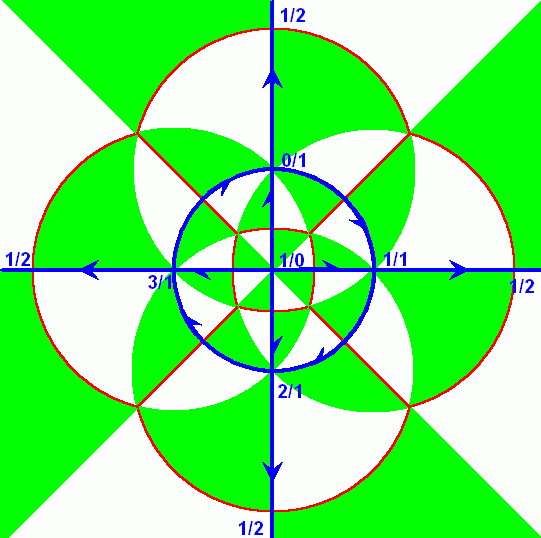 Fractions
modulo 4 on the cubic tiling.
Fractions
modulo 4 on the cubic tiling.
Here is a nice link explaining the relation of the Modular group to the
proof of Fermats
last theorem.
Tilings
with only one generator
So far, all tilings discussed
had 2 generators. But a
tiling with only one generator is also possible. Below is an example
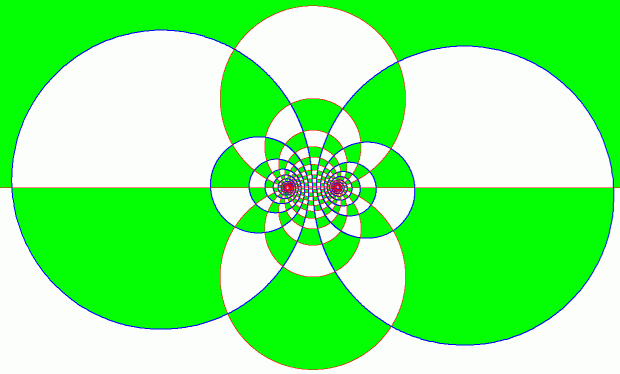 Spiralled
tiling with a
single generator.
Spiralled
tiling with a
single generator.
The tiling has 2 fixed points.
If you start from any point, and iterate the Mobius transformation, you
end up in one of the fixed points, the attractive fixed point. The
other fixed point is the attrator of the inverse transformation, that
we might call the repelling fixed point.
You can think of this tiling as starting from a fundamental
domain in the form of a small square near
the repelling fixed point, stepping around
in ever widening spirals around the point, until it starts orbiting the
attractive fixed point. The tiles then spiral towards the attractive
fixed point.
 Interestingly, these one-generator tilings are related to exact
solutions to the simplest non-linear differential equation:
Interestingly, these one-generator tilings are related to exact
solutions to the simplest non-linear differential equation:
dz/dt = Az2
+Bz
+ C (eq.1)
This is a generalisation of the
Logistic differential equation,
or Malthus-Verhulst equation:
dz/dt = r*z(1-z)
Whose exact solution is:
z = 1/(expt(-r*t)+1)
It turns out that the solution to the generalised equation (1) is:
z = (a*expt(r*t)+b)/(c*expt(r*t)+d)
(eq.2)
With:
A= r/K
B= r (1-2*z
-∞
/K)
C= r z
-∞ (1+z
-∞ /K)
a= (K+z
-∞)*(z0-z
-∞)
b= -z
-∞
(z0-z
-∞-K)
c= (z0-z
-∞)
d= -(z0-z
-∞-K)
z -∞
is the value for t=-∞
z 0
is the value for t=0
For t=∞, the value becomes z=(K+z
-∞)
Note that the solution (2) is a Mobius transformation!
Riemann
surfaces
Before we go on, we have to look our next piece of the
puzzle: Riemann
surfaces. Complex functions are
a bit hard to visualize, because we have 2 components that are a
function
of 2 components, so we need 4 dimensions. We will use color as a
visualization
aid. Suppose we color-code complex numbers, using brightness as a
measure
of magnitude, and the red/green/blue ratio as a phase. The identity map
would
look something like the left picture below:
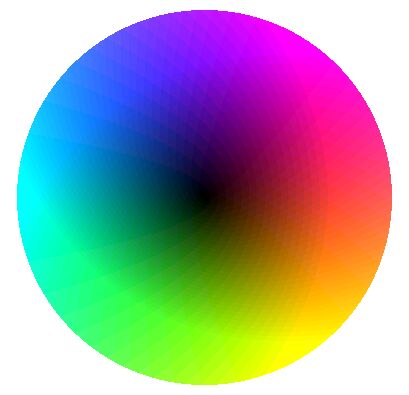
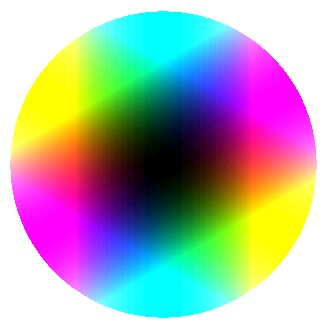 Color coded complex map of the
z (identity) and z2.
Color coded complex map of the
z (identity) and z2.
The right hand picture above is of z2.
Each
color now occurs twice, the phase has halved its periodicity.
If we make a picture of z1/2,
we have
to choose which square root we want, since there are 2. Lets draw both:
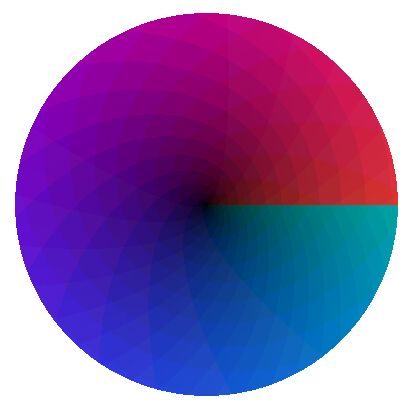
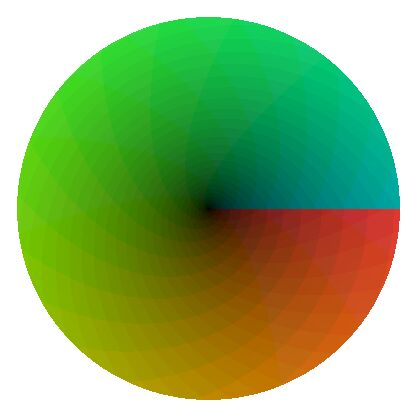 2 blades of the map z1/2
2 blades of the map z1/2
The 2 blades of the function z1/2
each contain
only half the colors, and each contain a discontinuity in the coloring.
The nice idea Riemann had, was to take the individual blades of
multivalued functions, and glue them together into a single surface in
such a way, that
the discontinuity in the colors is also removed. In this case we would
cut along the positive
real axis, and glue back using the colors as a guide. This can only be
done by a self-intersection in 3D space, but 3D
space sucks anyway. Riemann surfaces turn out to have incredible
properties.
Note that there are points in which different blades have the same
value.
These are called branch points. In the above example, there is a branch
point
at the origin.
A slightly more complex surface is that of Fermat's quartic. The
complex function
for this is (-1-z4)1/4.
It has 4 blades and 4 branch points.
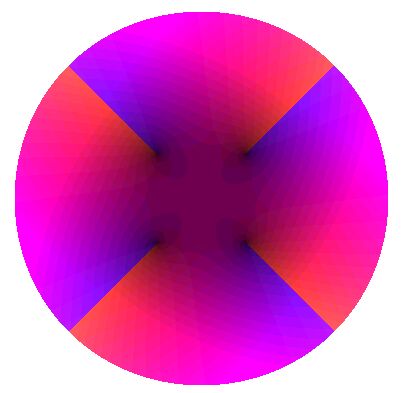 The first of 4 blades of the
Riemann surface of Fermat's
quartic.
The first of 4 blades of the
Riemann surface of Fermat's
quartic.
Before moving on with Riemann surfaces, I want to mention another way
of depicting them.
Phase
flow plots for depicting complex
functions
While thinking about tilings and Riemann surfaces, I developed a
visualization technique for complex functions, that I will call a
'phase
flow plot'. Below is a phase flow plot of the complex plane f(
z)
=
z.
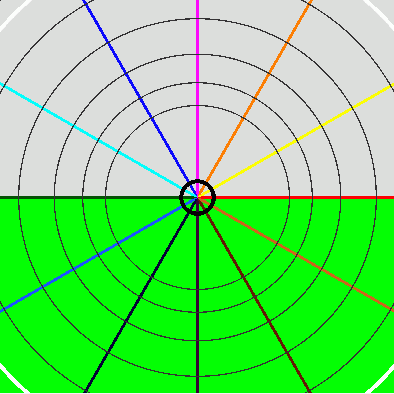 Phase
flow plot of f(z)=z.
Phase
flow plot of f(z)=z.
Here is how the phase flow plot works:
1. If the imaginary part is <0, we
use color
green, otherwise light gray. This produces a tiling of the plane with
green/grey tiles.
2. If the phase is very close to a set of
preset
values, (0, π/6, π/3, π/2…), we use a
color associated
with that phase. This produces lines of constant phase.
3. If the magnitude is close to a set of
preset
magnitudes, the color is made dark grey. This produces lines of
constant magnitude.
4. Special magnitude lines are reserved
to indicate
poles and zero’s. These produce a black circle around a zero,
and
a white circle around a pole. (A pole is a point of infinite magnitude.)
Here are the colors I use for the phase:
 The
color map for phase flow plots.
The
color map for phase flow plots.
One reason for using this method is that it shows more clearly the
relationship between complex functions and tilings. Another reason is
that it highlights cool property of complex functions: They are
determined by the poles and zeros, and lines of constant phase are
analogous to field lines flowing from poles to zeros. That’s
why
I call these plots phase flow plots.
In the map f(
z)
=
z,
the pole is at infinity, so it
cannot be seen. Below is a Mobius transformation of the map f(
z)
=
z,
the map f(
z)
= (
z-i)/(
z+i).
Now we see more clearly both
the a pole and a zero, and a flow of phase lines between them.
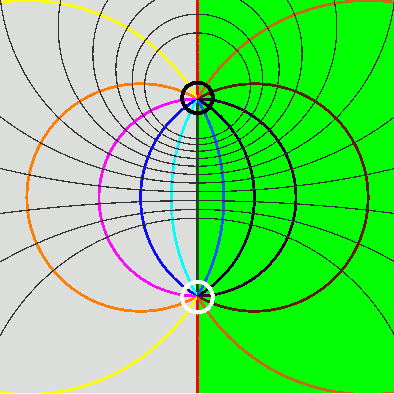 The
function f(z) = (z-i)/(z+i), (A
Mobius transformation of f(z) =z ) showing lines of constant phase
flowing from pole to zero. A zero is a ‘south
pole’: Its
logarithm is -infinity.
The
function f(z) = (z-i)/(z+i), (A
Mobius transformation of f(z) =z ) showing lines of constant phase
flowing from pole to zero. A zero is a ‘south
pole’: Its
logarithm is -infinity.
Analogy
between phase flow plots and electric
and magnetic fields
If phase flow plots reminds you of magnetic fields, it is because the
correspondence is exact. Electric fields, magnetic fields, potential
flows, heat conduction flows, are all solutions to the Laplace
equation. The real and
imaginary parts of a complex function also satisfy the Laplace
equation. Since
Log(
z)
=
Log(|
z|)
+ i Phase(
z)
, we know that the logarithm of the magnitude satisfies the Laplace
equation. Using the logarithm of the magnitude instead of the magnitude
itself has some interesting consequences. First, zeros have a
logarithm of –infinity, so they become
‘Negative’ or
‘South’ poles, with the complex poles corresponding
to
‘Positive’ or ‘North’ poles.
Second, the ‘charge’ of a pole is, as in Gauss
theorem,
equal to the number of field lines emanating from it. It does not
change if the function is multiplied by a constant. (The constant just
adds a value to the logarithm of the magnitude.) This now reveals a
really

: The charges are
discrete! In
nature, the fact that electric charges come in multiples of the
elementary charge seems mysterious, but for complex functions, it is a
necessary consequence from the fact that poles and zero’s
have
integer order!
Let’s plot some more examples. Here is a Mobius
transformation of
f(
z)
=
z2:
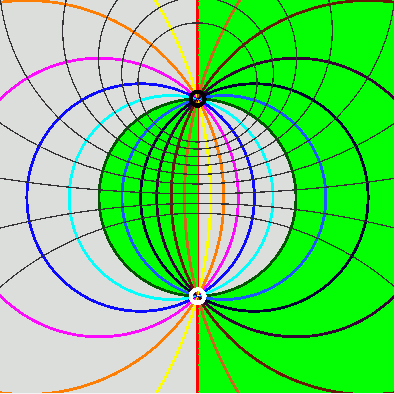 The
function f(z) = ((z-i)/(z+i))2
The
function f(z) = ((z-i)/(z+i))2
In the above figure, the pole and zero now have order 2. The
charges have doubled. Notice also the tiling has changed: There a now 4
bigons. (A bigon is a polygon with 2 sides).
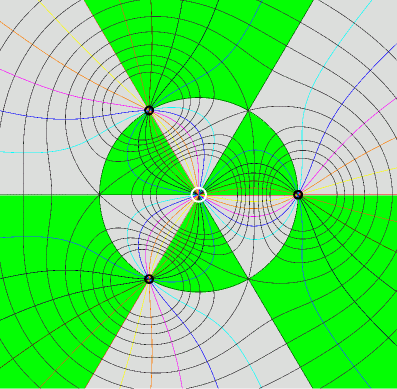 A
function with order 3 poles
at zero and infinity, and 3 order 2 zero’s. f(z)=(z3-1)2/z3
A
function with order 3 poles
at zero and infinity, and 3 order 2 zero’s. f(z)=(z3-1)2/z3
In the above plot, the lines coming from a pole are divided among 3
zero’s, while the lines going to a zero come from 2 different
poles. This means that there are ‘bifurcation
points’,
where the lines have to choose. In these points, the field strength is
zero, or alternatively, the derivative of f(
z)
is zero. Sometimes these are
normalised to correspond to unity, so we could call these points
‘ones’. But we’ll call them stationary
points. In the
above plot, the triangle vertices coincide with poles, vertices and
stationary points. Each pair of green/gray tiles contains each complex
number exactly once.
While we are at it, here some more phase flow plots:
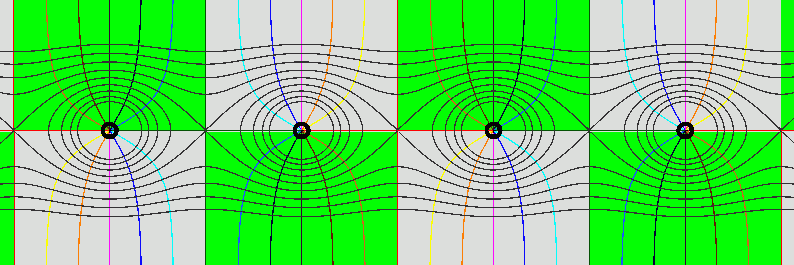 The
complex sine function, which has
a row of zeros at nπ, and poles at infinity.
The
complex sine function, which has
a row of zeros at nπ, and poles at infinity.
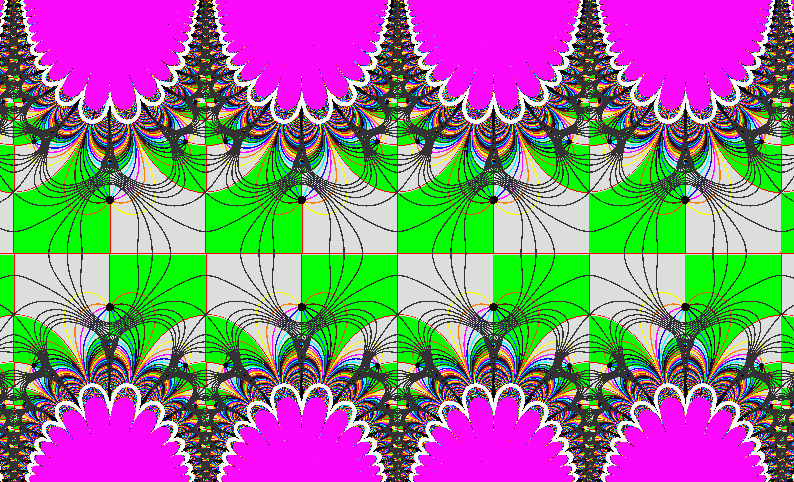 Phase
flow plot of the function
sin(sin(sin(z))), just because it is pretty.
Phase
flow plot of the function
sin(sin(sin(z))), just because it is pretty.
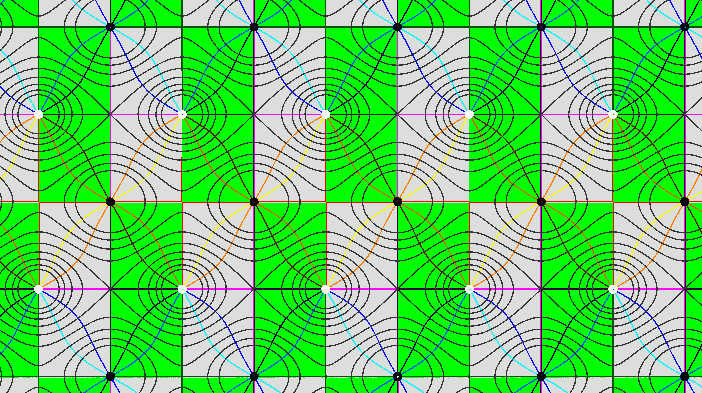 Phase
flow plot of the Jacobi
elliptic function f(z) =
sn(z,1/4). This function is double
periodic, it has poles and zeros distributed over a rectangular grid.
Phase
flow plot of the Jacobi
elliptic function f(z) =
sn(z,1/4). This function is double
periodic, it has poles and zeros distributed over a rectangular grid.
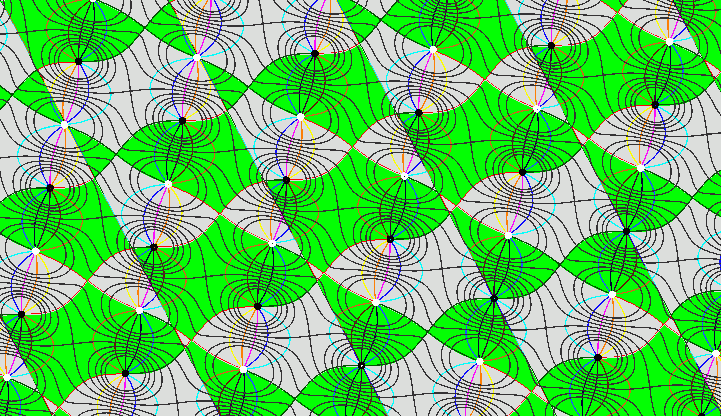 Phase
flow plot of the Jabobi
elliptic function f(z) = sn(z,1/2
+ i/3).
Phase
flow plot of the Jabobi
elliptic function f(z) = sn(z,1/2
+ i/3).
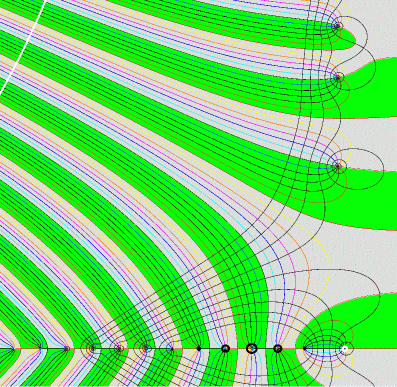
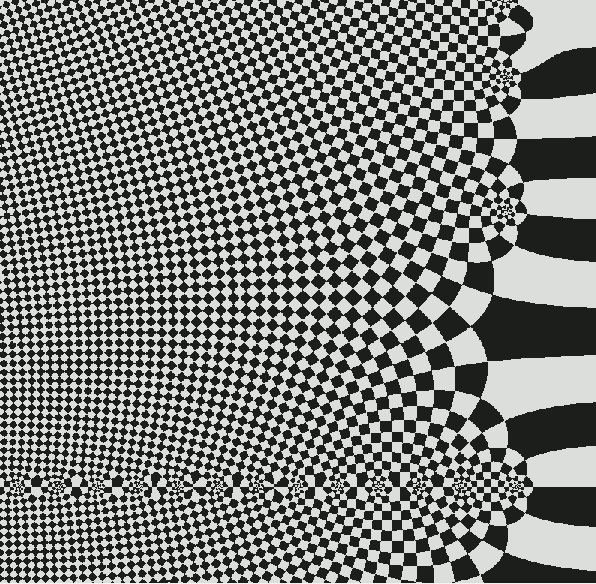 Phase
flow plot of the
Riemann
Zeta function. This famous
function has a pole at z=1, equally spaced zero's at z= 0, -2, -4,...,
and irregularly
spaced zero's on the "critical line" real(z) = 1/2. The Riemann
Hypothesis, which is often cited
as the top open problem of mathematics, is that these are the only
zero's.
Phase
flow plot of the
Riemann
Zeta function. This famous
function has a pole at z=1, equally spaced zero's at z= 0, -2, -4,...,
and irregularly
spaced zero's on the "critical line" real(z) = 1/2. The Riemann
Hypothesis, which is often cited
as the top open problem of mathematics, is that these are the only
zero's.
On the right, An animation in which the lines of equal phase anf equal
magnitude have the same interval, giving a square laatice, animated as
a checkerboard.
Note: I found out that people have been using plots somewhat similar to
phase flow plots called "phase plots". There is an online
expository article
on them here.
The authors mention that phase plots have been 'rediscovered' several
times. Still, phase flow
plots
are slightly different.
The most important property of a Riemann surface is its genus.
The genus of a surface is its number of "holes". A torus for example
has
genus 1, a sphere has genus 0. In a way, the stuff on this page is
about generalizing Platonic tilings to surfaces of higher genus.
There is a famous relation called
Euler's formula that relates the
Faces (F), Edges(E) and Vertices(V) of a tiling to the genus (g) of a
surface:
F - E + V = 2 - 2g
F - E + V is called the Euler
characteristic
of the surface.
It allows you to find the genus of a surface given a tiling, and
imposes
restrictions on which tilings are possible. For example, we can prove
that
a football must have 12 pentagons.
The formula for the Euler characteristics not so hard to prove. Just
start with a particular case,
lets say a cube. For a cube, we have F=6, E=12, V=8, and g=0, so it
satisfies
Euler's formula. Now whatever you do to the surface, it will not change
the
outcome of the formula. For example, if you split up an edge into 2
edges,
you increase E to E+1, but also V to V+1. If you interconnect 2
vertices,
you increase E top E+1, but also F to F+1.
If we take N
disjoint genus 0 surfaces, the Euler
characteristic will be 2N.
Now, we will start gluing them together.
Lets assume that the gluing always involves 2 identical
faces on 2 distinct surfaces. The gluing process destroys these 2
faces, and destroys
a loop that goes round one the faces. The loop consists of n
Vertices and n
edges, so we have for each glue
operation:
Glue 2 faces : F-> F-2, (V-E) stays constant,
Euler
characteristic -> Euler characteristic -2
So each time we glue, we will reduce
the Euler characteristic by 2.
As we continue gluing together the disjoint surfaces, we reduce the
Euler characteristic by
2 for each glue operation, until we are back at Euler characteristic 2,
with all
surfaces connected into a single genus 0 object.
So far, we have glued together disjoint surfaces. But we could also
glue part of a surface to itself.
We will
reduce the Euler characteristic by 2. But
at the same time, we will have increased its genus!
Another way to define the genus is the maximum numbers of
closed loops you
can cut through the surface without letting it fall apart. This
definition
works for discrete networks as well as continuous surfaces, and it
relates
to the inverse of "gluing", that I talked about.
Automorphic
functions
Platonic tilings are about symmetry, and complex functions themselves
have can have symmetry. What we need
to understand is how symmetry of a Riemann surface is related to the
actual equations of the defining the surface. Some of the the previous
pictures of Riemann surfaces, such as the
the one of z2,
already show
some symmetry. This function is symmetric under the group of
Mobius transformations {z, -z}.
Functions that are symmetric under a group of Mobius transformations
(G) are called automorphic functions. Specifically, for any z, an
automorphic function (f) has:
f(G(z)) =
f(z)
Let's build an automorphic function, in this case the one for
the
(2,3,2) tiling. One way to do it is to put poles and zero's on
the vertices of the tiling. In this case, we put poles of order 3 at
the vertices at ±i, and zero's of order 2 at
0, ±√(3).
f(z) = z2(z2-3)2/(z-i)3(z+i)3.
The resulting automorphic function is shown below.
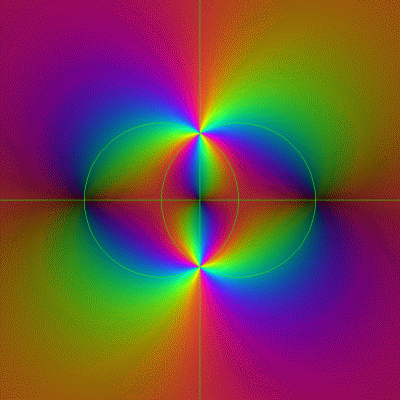
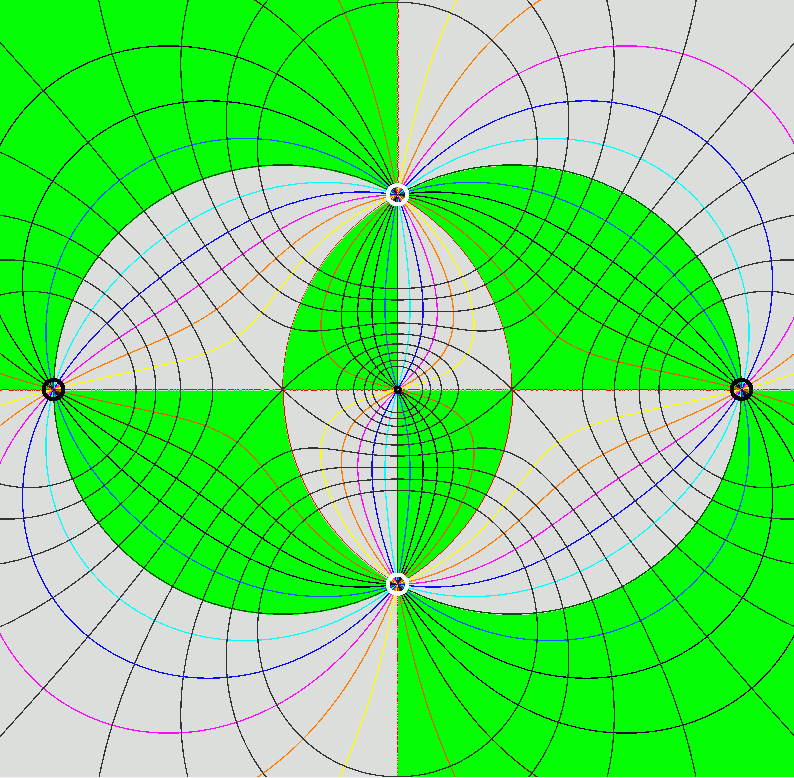 Automorphic
function
associated with the (2,3,2) tiling. On the right is the phase flow plot.
Automorphic
function
associated with the (2,3,2) tiling. On the right is the phase flow plot.
One nice thing is that any function of an automorphic function is also
an automorphic function. We can use this to build a "hyper-automorphic"
function, by not using f(z), but f(f(z)),
f(f(f(z))) etc.
This produces functions that is not only automorphic, but each tile is
itself is automorphically subdivided into smaller tiles. We
get automorphic
fractals,
as shown below
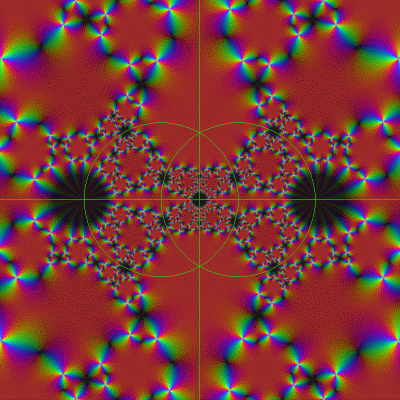
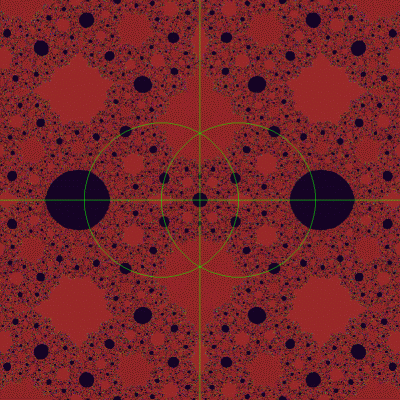 The
automorphic
function, iterated 3
times and 20 times respectively. In the right image, we seem to see
Mandelbrot-like structures.
The
automorphic
function, iterated 3
times and 20 times respectively. In the right image, we seem to see
Mandelbrot-like structures.
We can find explicit
expressions for the transformations
under
which automorphic fractals are invariant. If G is the group of Mobius
transformations for the original function (f), then fn
is invariant under a transformations set (F), that is simply a
conjugation of G by fn:
F = f
-n G fn
Note that the elements of F are generally a multi-valued functions. So
F is not a group. But the multi-valuedness in fact generated all the
extra sub-dividing tiles.
Actually, a regular Julia
set, like the one for
f:z->z2 -0.1+
0.75i discussed earlier,
can be seen as an automorphic fractal, since the map is an automorphic
function for the group of Mobius transformations {z, -z}. Below is an
image of f8(z).
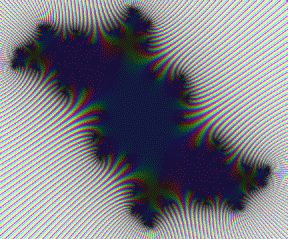
8
times iterated
Automorphic function z->z2
-0.1+ 0.75i
The
Julia set function has an infinite
pole at infinity, balanced by
infinitely many order 1 zero's that are located on the Julia set.
An automorphic function that is very important is that of the modular
group: the
j-invariant.
It has 3-fold zero's on the order 3 vertices, and infinite order poles
on the cusps at the real axis. At the order 2 vertices, the value is
equal to one. Below is a picture, borrowed from wikipedia.
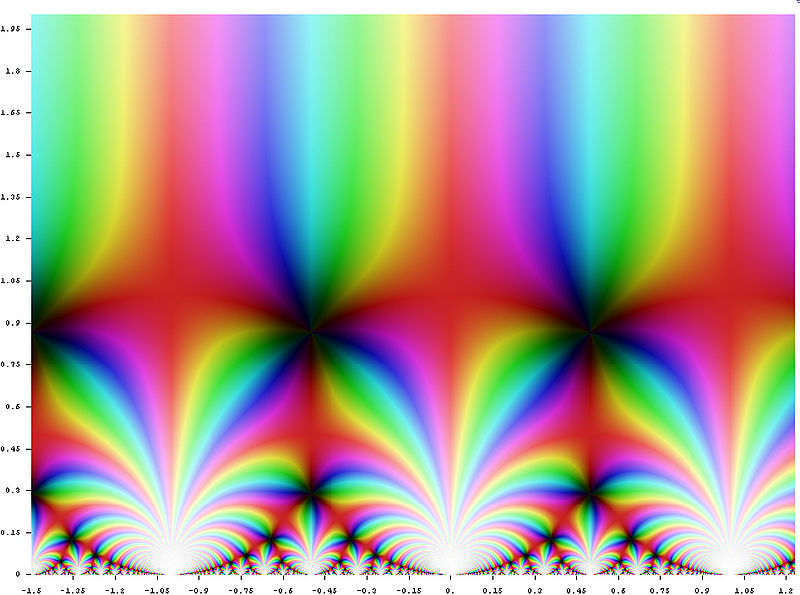 (Wikipedia
image:)
Automorphic function for the modular group: the j-invariant.
(Wikipedia
image:)
Automorphic function for the modular group: the j-invariant.
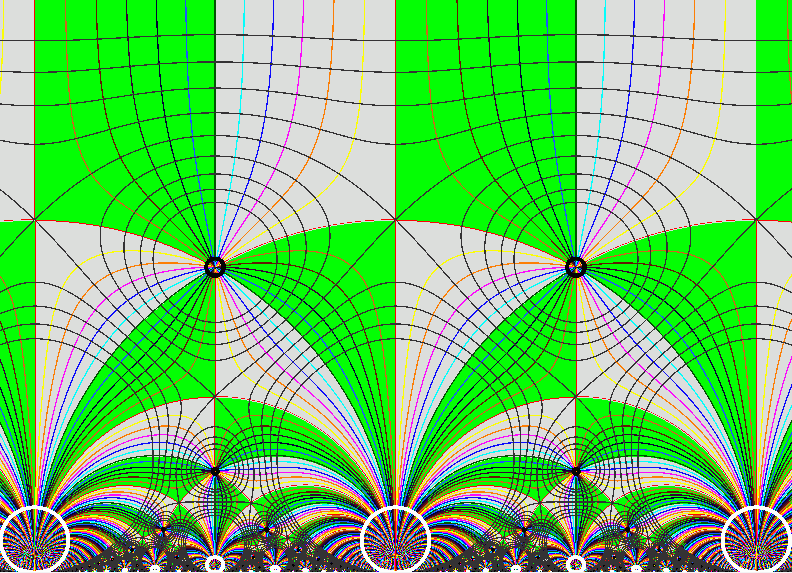 Phase
flow plot of the j-invariant.
Phase
flow plot of the j-invariant.
I made a website on a generalisation
of the Modular group, that I call the complex Farey tessellation.
Hyperbolic
models
Let's look at some models of hyperbolically tiled surfaces.
As I said, the Euler characteristic imposes restrictions of the
possible
tilings of a surface. If we consider tilings of Schlaefli symbol (p,3),
we
get the following possibilities:
Table of (p,3) tilings that
have the correct Euler
characteristic.
Genus:
0
1
2
3 4
----------------------------------------
p=3
3
0
<-
p=3
4
0
<-Tetrahedron
p=4
6
0
<-cube
p=5
12
0
<-dodecahedron
p=6
∞ 0/0
<-honeycombed
p=7
0
12 24
36
p=8
0
6 12
24
p=9
0
4
8
12
p=10
0
3
6
9
p=12
0
2
4
8
p=14
3
p=18
0
1
2
3
Table of (p,4) tilings that
have the correct Euler
characteristic.
Genus:
0
1
2
3 4
----------------------------------------
p=2
4
0
p=3
8
0
<-octahedron
p=4
∞
0/0
<-checkerboard
p=5
0
8
16
24
p=6
0
4
8 12
p=7
0
8
p=8
0 2
4
6
p=9
0
4
8
12
p=10
0
4
p=12
0 1
2
3
The red
entries have the
additional property that the quotient surface of
a p-cycle also has the Euler characteristic of a Riemann sphere, the green
entries
that of a torus.
It is fairly easy to tile a torus in a Platonic way. You can do it with
a
square number of squares, for example. Here is one with 4 hexagons. The
hexagons
have been folded, so they are not so easy to recognize.
This figure does look a bit boring, I admit.
A somewhat prettier figure is the tiling of "Fermats
quartic", with 12
octagons. All octagons are the equivalent, and are also folded in an
identical way. This figure has genus 3. It has tetrahedral symmetry. I
now realize
it is not Platonic. I still have to make the Platonic tiling with 12
octagons
of genus 3, which is known to exist.
The dual of this shape is a shape consisting of an inner icosahedron
and
an outer icosahedron, connected by 4 triangular holes:
A
platonic tiling of a genus 2 object by 6
octagons. (folded over the
holes):
I accidently reivented this model years later (shown on the right),
when I was is a discussion about the Bolza
surface.
This thing is called the Bolza's surface!
The dual of this one is an inner and outer octahedron, connected by 3
slits on 3 disjoint edges:
A platonic tiling of a genus 2 surface with 8 pentagons:
In the newsgroup sci.physics.research, we were discussing a heptagonal
tiling
of a genus 3 object, that we call "Klein's Quartic".
A summary of the discussion is on John Baez's page, here.
It was this discussion which triggered a lot of my interest on this
subject.
Before trying to understand Riemann surfaces and Mobius
transformations,
I was trying to glue together this Klein's Quartic.
The first construction with heptagons is a tiling of the outer shell of
a
genus 3 object, using 12 identical regular creased heptagons.
All heptagons are creased in the same way.
You can use this figure to build higher genus surfaces, by
interconnecting
the holes of this figure with other holes of the same figure or with
holes
of other copies of the same figure.
If you take 2 copies of it, and interconnect the loose ends, you get
24 heptagons, with 3 heptagons meeting at each of its 56 vertices. So I
thought
"Aha, Klein's quartic!". But no. You can travel around the edges, going
Left-right-left-right, (LRLR) etc. after a while, you end up in the
same
place. This is what I call "driving instruction symmetry".
Klein's
quartic has the property
(LR)4
= 1.
For all points. This figure does not. I had a lot of difficulty trying
to to build the correct surface, until I read part of Felix
Klein's original article
. Klein suggest that his figure should have octahedral symmetry, and
that
the 6 vertices of the octahedron are of at infinity. At infinity, the
heptagons
join up with the heptagons diametrically opposite. Because the surface
has
infinite points, it is perhaps justified not to try and glue together
the
heptagons at opposite sides of the octahedron. This makes life a lot
easier!
The resulting surface is shown below.
Here is how to deform the open octahedral surface into a closed
tetrahedral one:
Maybe I should quit maths and start a bakery.,..
The idea of not gluing together opposite sites opens up a new
possibility: what if we glue it to a copy
of
itself. Thus, we get an infinite lattice, known as an infinite
polyhedron.
A web page on these is here.
Infinite polyhedra have all vertices identical, just like "ordinary"
polyhedra. Their surface has negative curvature (i.e. it is
hyperbolic). A unit cell of them
glued to itself is again a closed Riemann surface. Some infinite
polyhedra
have the property that all faces are planar. For example, (3,3,3,3,3,3,3)
is an infinite polyhedron with planar faces, that looks like
icosahedra connected by octahedra. It is the dual of a (7,3) surface,
but not Klein's quartic: It is the dual of the cardboard model of the
tetrahedral (7,3) surface. The infinite polyhedron that is the dual of
Klein's Quartic is a (3,3,3,3,3,3,3) structure formed by
interconnecting each square face of snub cubes with square antiprisms.
Looking at our heptagon models, it can be noted that they can be formed
by taking a polyhedron built from triangles, and replacing the
triangles by 3 heptagons (These 3 heptagons have the same color in the
pictures). This idea can be extended: We can do it to an
icosahedron, as shown below.
The icosahedral figure has 60 heptagons, and by joining the
holes we get a genus 6 surface.
But we can go even further, because the the surfaces formed are (7,3),
so they too can be thought of as composed of triangles. For example,
the icosahedral figure would lead to a figure with 420 heptagons,
producing a genus 36 surface. Surfaces Platonically tiled by (7,3)
patterns are called Hurwitz
surfaces.
They have the special property that they posses the maximum number of
symmetries for a surface with a given genus, namely 84(g-1). This
follows from the fact that (7,3,2) triangles are the smallest (k,l,m)
hyperbolic triangles.
 The
Monster group is also a
Hurwitz surface.
The
Monster group is also a
Hurwitz surface.
An
alternative way to embed
tilings in 3
dimensional space is to allow intersections. I used to dislike
intersections, until I saw the work of Rinus
Roelofs.
Rinus Roelofs has made cool sculptures, that can be seen as Platonic
tilings of Riemann surfaces. To change the drawback of intersections
into an artistic feature, he moves the faces slightly apart and cuts
holes in them. Below is an example (chosen to clearly illustrate the
connection with tiled Riemann surfaces)
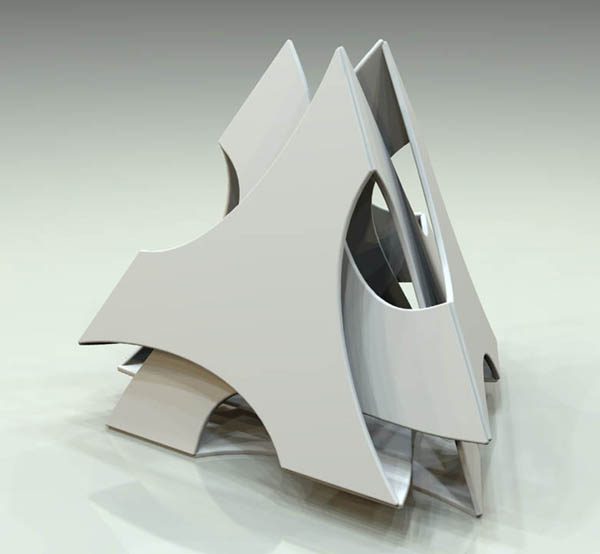 A
sculpture by Rinus
Roelofs that can be viewed as a (6,3) tiling.
A
sculpture by Rinus
Roelofs that can be viewed as a (6,3) tiling.
You can look at this sculpture as an inner tetrahedron and an outer
tetrahedron. But each edge joins a face from the inner with a face from
the outer. It turns out that  the edge
of each 'hole' forms a knot!
the edge
of each 'hole' forms a knot!
The Euler characteristic of an inner plus an outer polyhedron is 2*2=4.
After you identify the vertices of the inner and outer polyhedra, the
Euler characteristic becomes
Euler = 2*layers - vertices* (layers-1)
In the table below, I computed the genus for various combinations (The
number of faces meeting at a vertex needs to be odd)
layers
2 3 4
tetrahedron
1
2 3
cube
3 6 9
dodecahedron
9 18 27
icosahedron
5 10 15
On his website Rinus Roelofs has pictures of may of these, and of some
of them he made physical models.
A common way to talk of the genus of a Riemann surface is the
number of 'Holes". In these surfaces, I do not see where the
holes are. But the 'offical' defintion of the genus is the
'maximum number of cuttings along closed simple curves without
rendering the resultant manifold disconnected'. So there should be a
way to cut the double tetrahedroin, which has genus 1, along
a
closed loop without letting it fall apart. This seems indeed to be the
case: You can do it by cutting the tetrahedron along a Petrie
polygon.
The surfaces by Rinus Roelofs remind of Seifert
surfaces: A surface bounded by a
knot. there is probably a
relation, but I haven't cleared my mind on this yet.
Tilings
of surfaces of constant
negative Gaussian curvature
The Platonic polyhedra are tilings of the sphere: the only
complete surface of
constant positive curvature. The sum of the angles of the faces meeting
at each
vertex is less than 360 degrees by a number called the angular deficit:
If the angular deficit is zero, then the surface is not (intrinsically)
curved at that point. Now let us compute the total angular deficit of
each Platonic polyhedron:
Tetrahedron:
4 X (360-4X60) = 720
Octahedron:
6 X (360-4X60) = 720
Cube:
8
X (360-3X90) = 720
Icosahedron:
2 X (360-5X60) = 720
Dodecahedron:
20 X (360-3X108)= 720
Coincidence?
No, its the Gauss-Bonnet theorem at work!
The Gauss-Bonnet theorem relates the total curvature of a surface, that
is the
curvature integrated over the surface, with its topology. It states
that the total curvature of a surface is equal to 2π times its
Euler
characteristic.
Just check for Klein's quartic:
Klein:
56 X (360-3X180X5/7)= -4X360
The power of this theorem is that it works no matter how we deform the
surface, or add extra tiles: The sum of the angular deficits remains
the same.
OK, so this means that hyperbolic tilings tile a surface of negative
curvature. But it would be nice if this surface had constant
negative curvature, just like the sphere has constant positive
curvature. Searching for such a surface, we quickly run into a
discouraging
theorem due to Hilbert:
There is no complete regular surface of constant negative curvature in
3 dimensions. However, while reading some fascinating stuff on Circle
Packings,
I could not help thinking there must be a surface with constant
negative curvature, that can be generated using circle packing
algorithms. Especially, the so called Schwarz
P surface looked suspiciously
like my cardboard octahedral
Klein surface.
At this point, I should mention that the Schwarz surface does have
constant mean curvature, but not constant Gaussian curvature. We can
approximate the surface locally in suitable coordinates (x,y) as:
z = a x2
+ b y2.
(x and y are not necessarily orthogonal in this case)
Then the mean curvature is (a + b), while the Gaussian curvature is a*b.
The latter fact has the honor of being called the "Theorema Egregium"
of Gauss.
The mean curvature is important, because a surface of zero mean
curvature, called a
minimal surface,
is a property of soap bubbles (if they are not pressurized like in a
spherical bubble). Many pictures of minimal surfaces are on the web.
Note that zero mean curvature is compatible with negative Gaussian
curvature.
Gaussian curvature is also called intrinsic curvature, because it can
be determined completely independently of the space in which the
surface is embedded in. You only need to know the angular deficits at
each point, while for the extrinsic curvatures, you need to know the
coordinates of the point in 3D, or whatever space you are in.
So I set out to deform Schwarz surface using my own circle packing
algorithm. In a separate page, I will talk about this algorithms. But
here, I will go straight to the end results, the first picture is below:
To view this interactively in 3D, using VRML, click here.
 (Extra picture for search engine related reasons)
(Extra picture for search engine related reasons)
The picture shows how a (6,4) hyperbolic tiling covers a surface of
 constant
Gaussian curvature!
Furthermore, the surface can obviously be
used as an elementary cell in the fashion of infinite polyhedra. In
this
case, (4,6)
infinite polyhedron as well it's
dual (6,4)
infinite polyhedron,
can be seen as a tiling of a
surface formed from units as seen above.
constant
Gaussian curvature!
Furthermore, the surface can obviously be
used as an elementary cell in the fashion of infinite polyhedra. In
this
case, (4,6)
infinite polyhedron as well it's
dual (6,4)
infinite polyhedron,
can be seen as a tiling of a
surface formed from units as seen above.
Notes:
The surface has 8 congruent hyperbolic hexagons, which have 90 degree
angles at their corners.
The figure can also be seen as 12 hyperbolic squares
The hexagons are split up into 12 congruent
(π/4, π/6, π/2)
triangles.
The vertices of the small triangles are centers of the circles of the
circle packing. At each of the vertices, the angular deficit, weighted
by the area of the packing circle, is the same.
If you cut out any of the 96 hyperbolic triangles, you could glue it
exactly on top of any other, because they are hyperbolic congruents.
The circle packing of each of the 96 hyperbolic triangles is the same:
they have the same radii as solution.
A cardboard model:
Because the sum of angles at each vertex is greater than 360 degrees, I
had use a zig-zag pattern of triangles, such that each vertex is at a
cut-line, as shown below.
Here is the surface constructed with a square tesselation. This is
based a circle packing with orthoganlly intersecting circles.
A lattice of these objects connected together:
The surface has the remarkable property  that the "holes" of the
lattice
are congruent to the lattice itself!
that the "holes" of the
lattice
are congruent to the lattice itself!
The self-complement property arises because the complement is also
tiled
by exactly the same hyperbolic triangles. The property of
self-complementarity is also present in the closely related the Schwarz
surface, and in the (4,6)
infinite polyhedron
and the (6,4) infinite polyhedron. These 4 surfaces are part of a
family that can be
continuously deformed into one another, while maintaining
self-complementarity, a bit like self complementary Escher Drawings.
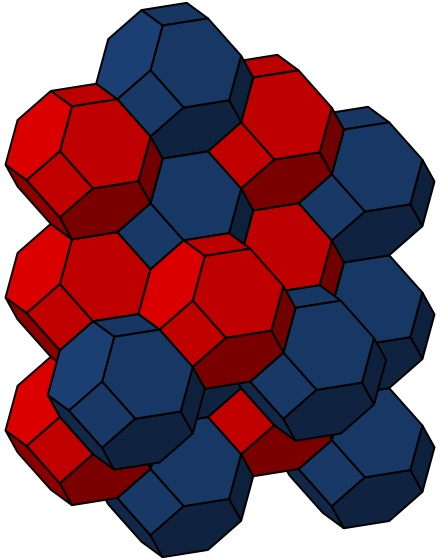 (Wikipedia
image) A
"bitruncated
cubic honeycomb", or (6,4) infinite polyhedron, part of
the self-complementary family.
(Wikipedia
image) A
"bitruncated
cubic honeycomb", or (6,4) infinite polyhedron, part of
the self-complementary family.
Yet
another interesting related surface, a double
ruled surface, also self
complementary:
I
saw this surface on Tadeusz Dorozinski's
website. I decided to make a quick and dirty model from string and
sticks.
Each rhombic patch in the model is a hyperbolic paraboloid, which is a
curves surface that can be made from 2 sets of straight lines. I didn't
do all of the second (green) set, because this would be quite a bit of
work.
One way to see that the self complementarity works, is that both the
primary surface and the complementary surface are generated by the same
symmetry plus a triangle bounded by the axis and the mirrors. Any triangle
bounded by
the axis and the mirrors will yield a self complementary surface.
Below is a picture of the reflection planes and rotation axis.
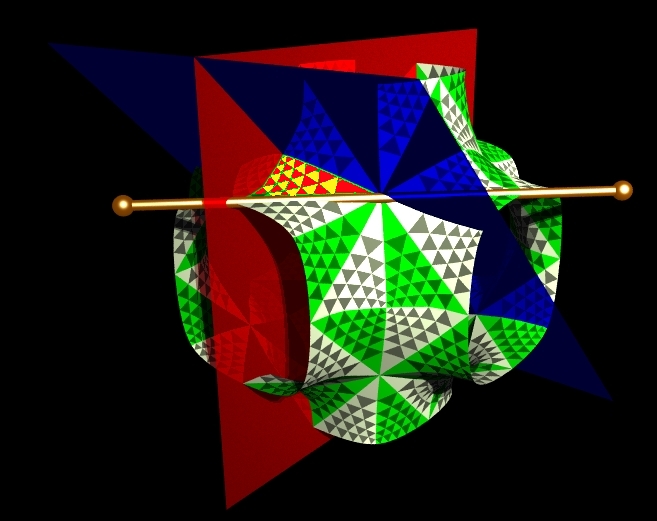 The self-complementary
family of surfaces all share the same symmetry group. This symmetry
group can be generated by 2 reflection planes, and a 180 degree
rotation. The reflection planes and the axis of rotation surround a
fundamental domain of the symmetry group (red/ yellow tiles)
The self-complementary
family of surfaces all share the same symmetry group. This symmetry
group can be generated by 2 reflection planes, and a 180 degree
rotation. The reflection planes and the axis of rotation surround a
fundamental domain of the symmetry group (red/ yellow tiles)
Here is a rendering of the corresponding circle packing, each circle
represented by a sphere.
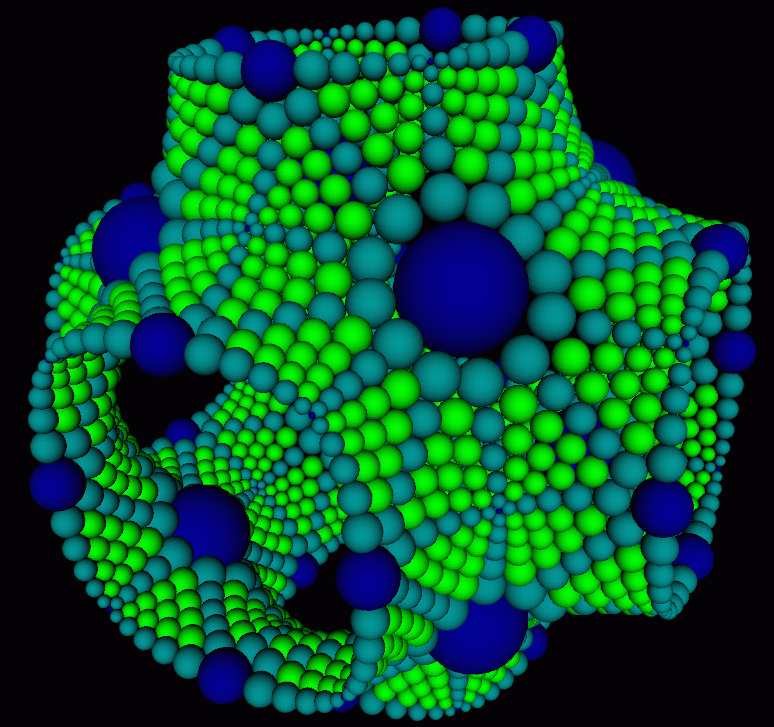
To get the above in vrml, click
here.
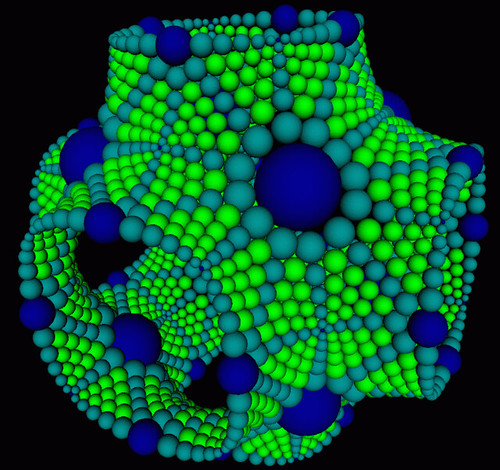 (Extra
picture for search engine related reasons)
(Extra
picture for search engine related reasons)
So what happened to Hilbert's theorem? Isn't this surface supposed to
be impossible?!
Well, the centers of the hexagons are a bit tricky. They are what I
call "ripple points". If we again fit an Euclidean plane to these
points,
we locally get (now in polar coordinates)
z = a r2
cos
(3*theta)
A wavy pattern of wavenumber 3 around the origin.
On any line through the origin, we have
d2z/ds2
= 2a.
So in a sense, the coordinate z is a smooth function of (x,y). However,
we cannot find a good approximation for the form:
z = a x2
+ b y2.
So we do not have a formula for the extrinsic curvature on these
points. While of course the intrinsic curvature is perfectly well
defined from the angular deficit. Because the ripple points have no
extrinsic curvature, they are not "regular"in the sense of Hilbert's
theorem. So Hilbert was right, but we can still make very beautiful
surfaces of constant negative Gaussian curvature, if we allow "ripple
points".
From a reaction from Dan Asimov, I learned to the Nash
Kuiper embedding
theorem. This theorem
states that there exist C1
isometric embeddings
of the hyperbolic plane as a complete surface in 3-space.
(Hilbert's theorem is about C2
isometric
embeddings). 'Isometric' means lengths are preserved, C2
means twice differentiable.
I related subject I found is the Monkey
saddle. This is almost like a
ripple point, except that all
curvature goes to zero in the 'Monkey saddle point'.
The circle packing algorithm adapts the size of each circle, so that
the angular deficit of the triangles formed by connecting the circle to
its neighbours is equal to a prescribed value. The algorithm outputs
radii, from which a set of edge lengths follows: an edge has a
length equal to the sum of the radii of the vertices it connects. From
the edge lengths, we need to reconstruct the surface, using another
algorithm. This second algorithm uses "Forces" proportional to the edge
length error to move the vertex coordinates in the right direction.
This sometimes produces crumpled surfaces, such as below:
These crumpled surfaces have the correct intrinsic curvature, but the
extrinsic curvature is a mess. To avoid crumples, we add a force that
tries to keep face angles minimal. this force needs to be relaxed to
zero as iterations progress, as they should not disturb the solution to
the circle packing.
Below is part of the constant Gaussian curvature version of the Schwarz
D-surface:
The Schwarz D-surface is, like the P-surface, a triply
periodic minimal surface. As I
learned from a discussion with
Stephen
Hyde,
you can take a hyperbolic hexagon from the Schwarz P-surface, and
isometrically deform it (tie bend the paper model), so that its 6 sides
attach to 6 straight edges of a cube. I''ll be making more of this soon,
When I started making circle packings, my goal was to tile a surface of
constant negative curvature
with 24 heptagons. So here it is:
To view this interactively in 3D, using VRML, click here.
Here is a rendering of the circle packing:
If you cut out any of the 336 hyperbolic triangles, you could glue it
exactly on top of any other, because they are hyperbolic congruents.
The circle packing of each of the 336 hyperbolic triangles is the same:
they have the same radii as solution.
The same applies for the 24 heptagons, and these don't even have to be
bent: They also identical in a extrinsic sense.
The
relation between
N-dimensional lattices and tilings
Tilings may seem like the simple version of their higher dimensional
analogs, N-dimensional lattices. But there is a surprising way in which
tilings actually describe structures of dimensions 3 and
higher!
We got a hint of this already, when we discussed that all finite simple
groups are tessellations of Riemann surfaces: so if a higher
dimensional
lattice has a symmetry group, it must also be related to a tiling.
One way to see lattices in a surface tiling is through the observation
that
consecutive reflections in circles that do not intersect are
translations. As an example, project the (6,4) tiling on the Riemann
sphere, by shining an imaginary light at the center through the
translucent surface, as shown below.
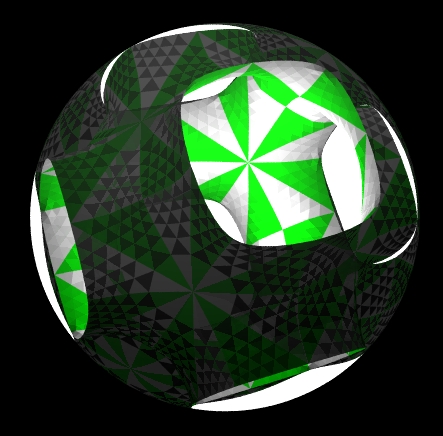 Projection
of the
Schwarz P-surface on to the Riemann sphere.
Projection
of the
Schwarz P-surface on to the Riemann sphere.
Next, we project the pattern on the Riemann sphere by our usual
stereographic projection onto the plane. We get something like the
truncated octahedron: 8 hexagons, with 6 squares, but the squares are
"holes". Make these holes into circles, and use the circles as
reflectors. In 3D, these reflections are just those that generate the
translations of the Schwarz_P lattice. In 2D, the reflections are again
circle inversions. In the picture below, the translation generating
circles are colored black.
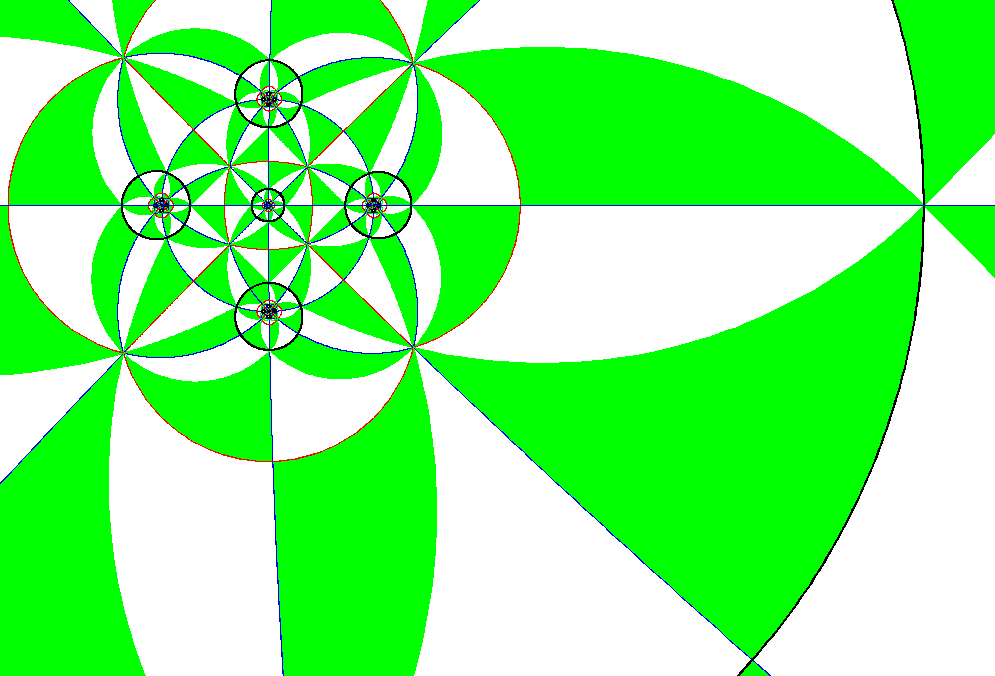 (6,4)
tiling, with the
black lines
representing reflections that generate translations. The
triangle
boundaries that are green (ie not blue or red) are circles, just like
the red, blue and black curves, but they do not correspond
to actual circle inversions in the complex plane. If they
were, we
would have obtained the usual Poincaré disk tiled with
(6,4,2)
triangles.
(6,4)
tiling, with the
black lines
representing reflections that generate translations. The
triangle
boundaries that are green (ie not blue or red) are circles, just like
the red, blue and black curves, but they do not correspond
to actual circle inversions in the complex plane. If they
were, we
would have obtained the usual Poincaré disk tiled with
(6,4,2)
triangles.
So the figure we made, shows in effect an entire infinite 3D lattice,
in 2D! In fact, the tiling is a multiple cover of the 3D lattice. In
the tiling, for example, UP-LEFT is leads to a different tile
than LEFT-UP, while in the 3D lattice, these tiles coincide,
Another remark about the above figure is that it looks different from
the usual (6,4) tiling of the Poincaré disk. If you generate
a
tiling
by reflections in the sides of a (π/2, π/4, π/6)
triangle, you always get the Poincaré disk. But in the above
picture,
I never use reflections in the green lines, only in the red, black and
blue lines. In that sense, it is a "quadrilateral group": It is
generated by reflections in the sides of quadrilaterals, each with a
green boundary line as a diagonal of the quadrilateral.
I believe this tiling is isomorphic to the (2,4,6) triangle group. But
it more clearly shows the relation with the 3D lattice.
Stephen
Hyde
has some nice on line articles on his website which exploit
the
connection between 2D tilings and 3D lattices to help understand the
latter. Lattices like these are an active research topic in Chemistry.
Another interesting fact I learned from Stephen Hyde's articles, is
that there are surfaces in chemistry that actually try
to minimize variations
in Gaussian
curvature (about some average value), rather than mean curvature.
The "Indra's
pearls" patterns are also
related to latices: They are
generated by 2 pairs of circle inversions, so they depict 2D lattices.
I tried making an lattice isometrically tiles with (7,3).
I tried to torque the model a bit so that it connects to
build an
infinite polyhedral "zeolite" structure. This does not appear to work
without crumpling.
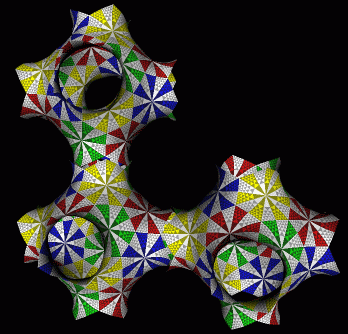 The Klein Quartic figures do not quite fit into a lattice.
The Klein Quartic figures do not quite fit into a lattice.
Isometric embedding of the
hyperbolic plane.
Playing
with circle packings, I
wondered if I could
actually render an isometric embedding of the hyperbolic
plane.
The only renderings I know that are on line are these crocheted
models.
Start with a the (5,4) tiling. If you try gluing together this tiling
with pentagons, you quickly find that the model tends to more and more
curl up in a seemingly uncontrolled fashion. To create some order, I
came up with a folding pattern. Divide the pentagons (excluding the
"center piece") into 2 types, that we color red and green. The red and
the green pentagons are folded as shown in the photograph below, which
are (for gluing reasons) based on an Archimedean version (5,4,4,4).
Each green pentagon then has 3 "children" in the outward radial
direction (R),
2 green and one
red. The red pentagons have 5 children, 3 green and 2 red. This pattern
can be repeated indefinitely, yielding a wavy pattern with
ever-increasing tangential wavenumber with increasing R.
A cardboard
model is shown below.
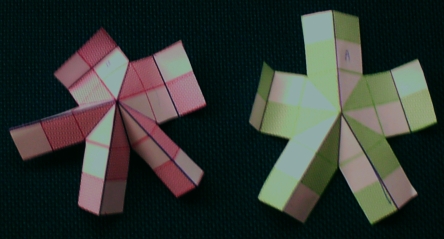
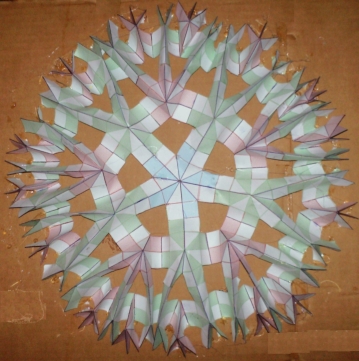 Photographs
of a folding
pattern for
an isometric embedding of the hyperbolic plane. Only the first
concentric rings of pentagons are constructed.
Photographs
of a folding
pattern for
an isometric embedding of the hyperbolic plane. Only the first
concentric rings of pentagons are constructed.
Next, I let loose the circle packing algorithm on this folding pattern.
The algorithm starts with a solution for a circle packing which has
constant negative Gaussian curvature. This packing is just a set of
radii and a connection topology. Next the algorithm tries to embed the
packing, by adapting the coordinates of the vertices so that each edge
length is the sum of the radii associated with the 2 vertices it
connects. Below is the result.
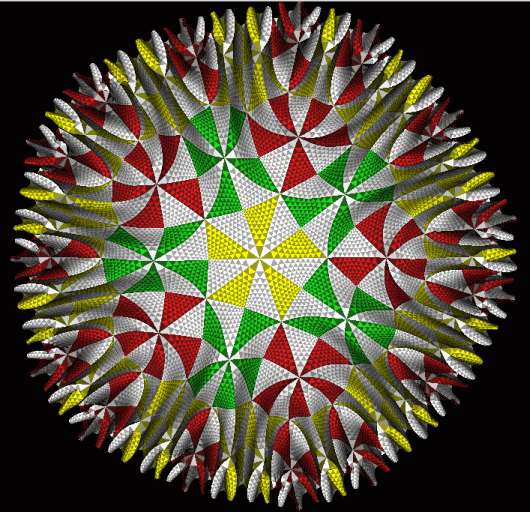
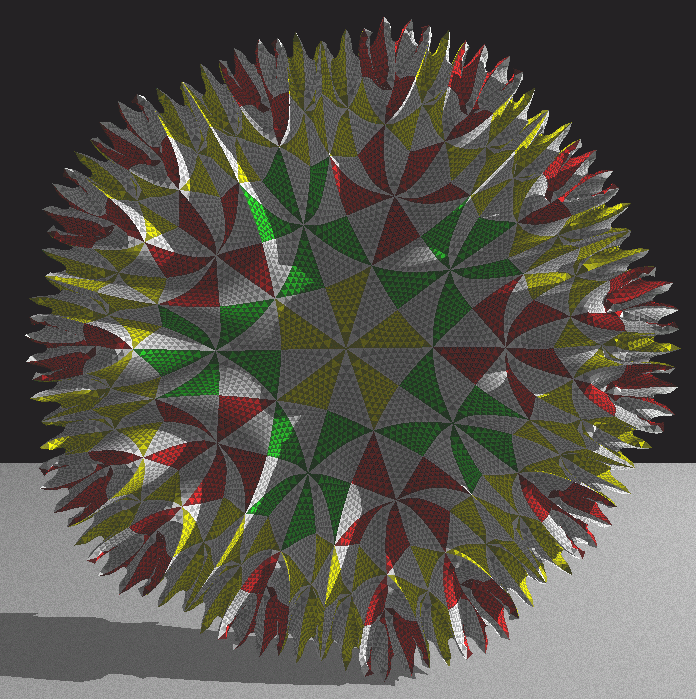 Rendering
of an
isometric embedding of the hyperbolic plane, based on a self similar
folding pattern of the (5,4) tiling. Only the first concentric
rings
of pentagons are constructed.
Rendering
of an
isometric embedding of the hyperbolic plane, based on a self similar
folding pattern of the (5,4) tiling. Only the first concentric
rings
of pentagons are constructed.
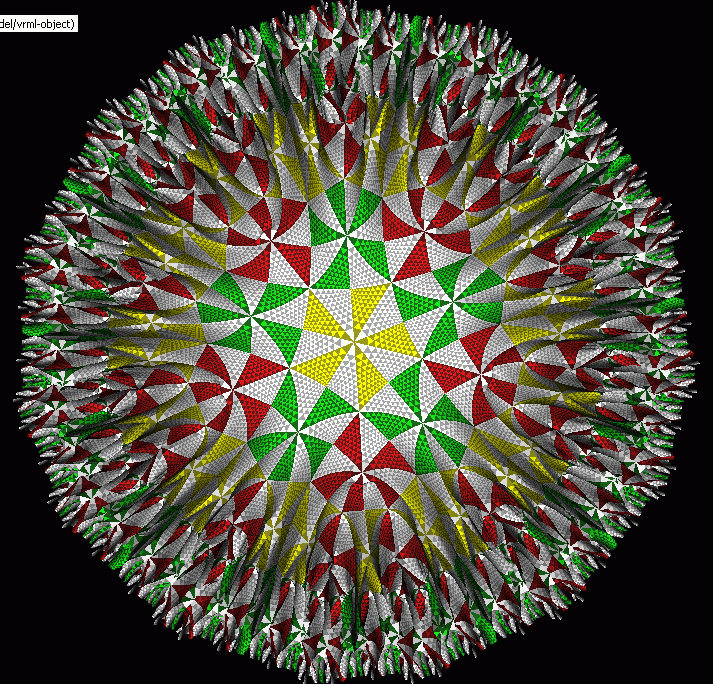
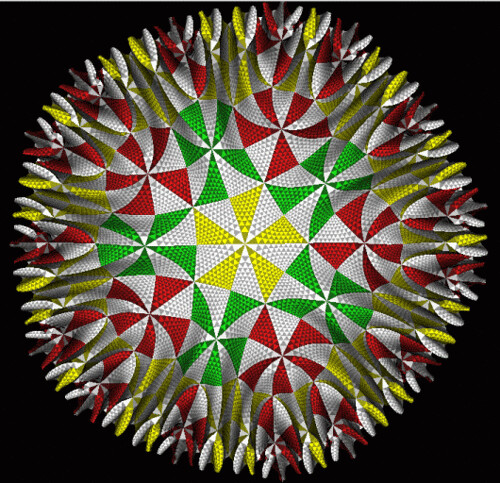
I do not know for sure that
the picture is actually a C1
isometric embedding, but it looks cool anyway.
Miscellaneous
Below is a "snub" version of the Klein surface.(7,3,3,3) I thought for
a while that it can build an infinite
skew polyhedron. But
unfortunately, the triangles turn out to
be not exactly
equilateral. Nevertheless, I don't feel like deleting the picture just
yet:
When I was on holiday, I had some heptagons with me to construct
Klein's quartic. Vincent Lokin joined me in my struggle. He cut up his
motorcycle
tire (which was leaking), and bravely started sowing the pieces
together. At that time, we had no idea what Klein's quartic should look
like, so we thought maybe if we just join everything together, the
flexible rubber would mold things in the right way. Unfortunately, it
is rather difficult. Below is our "
Zen and the Art of Motorcycle Geometry". Vincent suggested the name
"24-7".
(He is a banker, so he likes the 24 hour 7 days a week economy.)
With hind sight, rubber behavior probably doesn't help for finding a
hyperbolic
surface. The thing is, elliptic surfaces try to minimize area while
maximizing
the enclosed volume. We all know how something becomes round when you
inflate
it. But hyperbolic surfaces have "too much" surface. Most 3D
realizations
on this page have zero volume; the paper is folded so that the back
side
touches the back side of another part of the surface. Hyperbolic
surfaces
try to maximize area.
But it can be be done: Eveline
Séquin succeeded in
sowing a Quartic Quilt!
Finally, an animation of a Mobius transformation. Can you
spot the 2 fixed points?
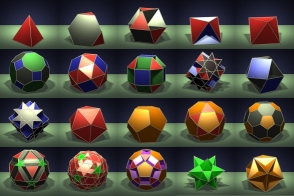
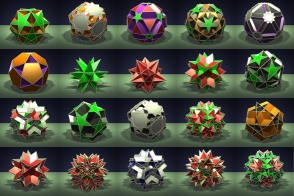




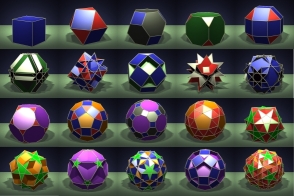
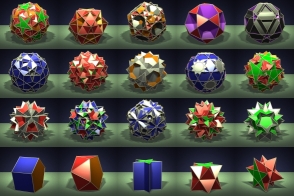


 (click to enlarge)
(click to enlarge) (Extra
picture for search engine related reasons)
(Extra
picture for search engine related reasons) .
It is shown that fractal-generating maps can be made into a group by
choosing a suitable Riemann surface to plot them on. We will look first
at
tilings that correspond to symmetry groups, and we get back to fractals
later.
.
It is shown that fractal-generating maps can be made into a group by
choosing a suitable Riemann surface to plot them on. We will look first
at
tilings that correspond to symmetry groups, and we get back to fractals
later. 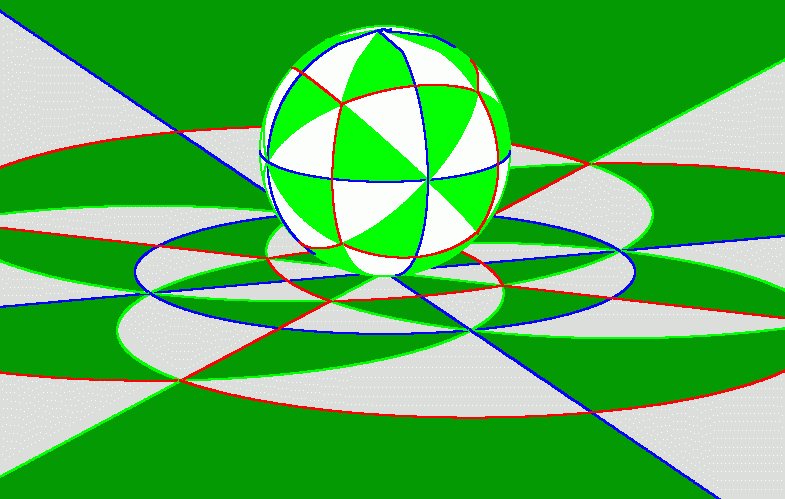
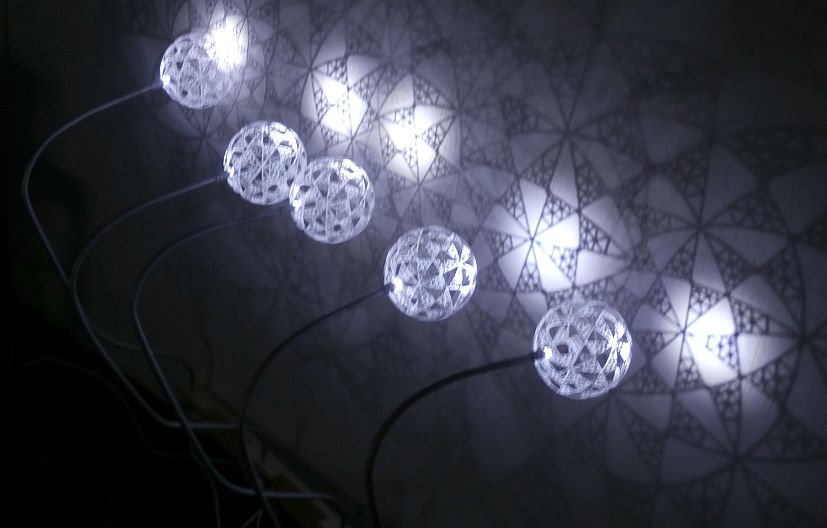
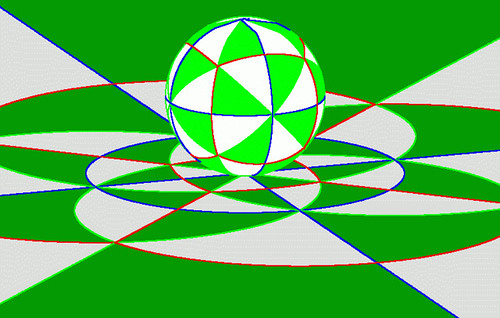 (Extra
picture for search engine related reasons)
(Extra
picture for search engine related reasons) (Extra
picture for search engine related reasons)
(Extra
picture for search engine related reasons) every
group that is presented by 2
generators, corresponds to a
tiling of a Riemann surface. To
see this we use a
very
nice way of constructing a "Cayley graph" of an arbitrary group
presented
by 2 generators. This method is used by Coxeter for the honeycombed
tiling,
and he remarks that it can be used for other tilings too. A Cayley
graph
shows the structure of a group by presenting its elements as vertices,
and
using color arrowed edges to represent which elements are mapped onto
each
other by generators. Each generator has a separate color. One thing you
can
do with a Cayley graph, is read of how to get from one element to
another
using generators. Just draw a path, and read off the generators from
each
edge. The resulting string of generators is called a "word".
All words
can be visualized using the Cayley graph. Suppose we have 2 cyclic
generators
Ap
= Bq
=1. Let C = (AB)-1,
so that ABC=1. C is also cyclic, Cr
=1. We can
now construct a planar Cayley graph, such as the one below, which is
for the tetrahedral group, for which A3
= B3
= C2
= 1.
every
group that is presented by 2
generators, corresponds to a
tiling of a Riemann surface. To
see this we use a
very
nice way of constructing a "Cayley graph" of an arbitrary group
presented
by 2 generators. This method is used by Coxeter for the honeycombed
tiling,
and he remarks that it can be used for other tilings too. A Cayley
graph
shows the structure of a group by presenting its elements as vertices,
and
using color arrowed edges to represent which elements are mapped onto
each
other by generators. Each generator has a separate color. One thing you
can
do with a Cayley graph, is read of how to get from one element to
another
using generators. Just draw a path, and read off the generators from
each
edge. The resulting string of generators is called a "word".
All words
can be visualized using the Cayley graph. Suppose we have 2 cyclic
generators
Ap
= Bq
=1. Let C = (AB)-1,
so that ABC=1. C is also cyclic, Cr
=1. We can
now construct a planar Cayley graph, such as the one below, which is
for the tetrahedral group, for which A3
= B3
= C2
= 1.


 The intersections of the modular tiling with the real axis are
exactly all the rational
numbers! I got that from the
book 'Indra's
Pearls'. This book is quite
related to this web page, so if
you like this page, you might want to read it.
The intersections of the modular tiling with the real axis are
exactly all the rational
numbers! I got that from the
book 'Indra's
Pearls'. This book is quite
related to this web page, so if
you like this page, you might want to read it.

 The stern brocot tree gives a 1-to-1 correspondence between the
rationals and binary strings. If left is '0' and right is '1', then you
can represent any rational by the driving instruction to get to it in
the Stern Brocot tree. For example, the number 3/4 would be '011',
while 4 would be '111'.
The stern brocot tree gives a 1-to-1 correspondence between the
rationals and binary strings. If left is '0' and right is '1', then you
can represent any rational by the driving instruction to get to it in
the Stern Brocot tree. For example, the number 3/4 would be '011',
while 4 would be '111'.
 The
radii of "kissing" circles are related by a
magical formula called the "kiss
precise".
The
radii of "kissing" circles are related by a
magical formula called the "kiss
precise".
 Ricci flow
sounds like heavy duty stuff, but discrete Ricci flow is simply
changing the sizes of the triangle in the triangulation so that the
local curvature "flows" to a prescribed value.
Ricci flow
sounds like heavy duty stuff, but discrete Ricci flow is simply
changing the sizes of the triangle in the triangulation so that the
local curvature "flows" to a prescribed value.








 (Extra picture for search
engine related reasons)
(Extra picture for search
engine related reasons) My hyperbolic Platonics have constant
negative
Gaussian curvature everywhere
except at the cusps, where
the curvature is positive infinity. In this sense, thy are nicer than the
ones at the mathworld site. For
more on constant negative
Gaussian curvature, click here.
My hyperbolic Platonics have constant
negative
Gaussian curvature everywhere
except at the cusps, where
the curvature is positive infinity. In this sense, thy are nicer than the
ones at the mathworld site. For
more on constant negative
Gaussian curvature, click here.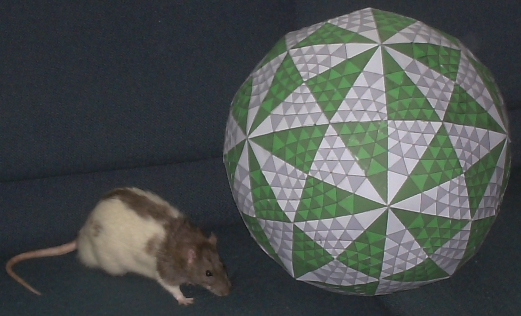
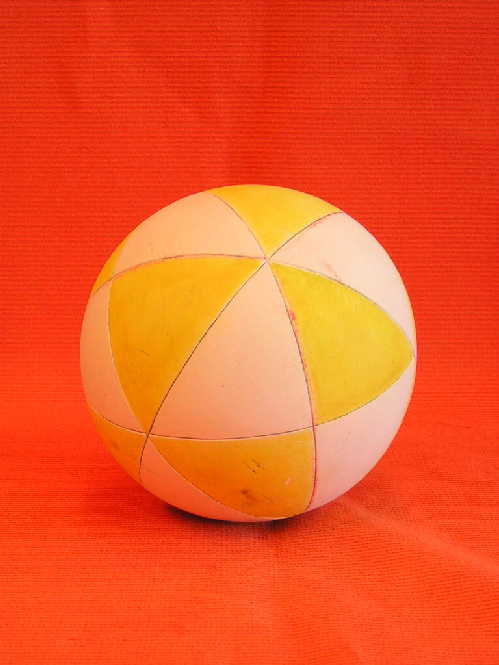
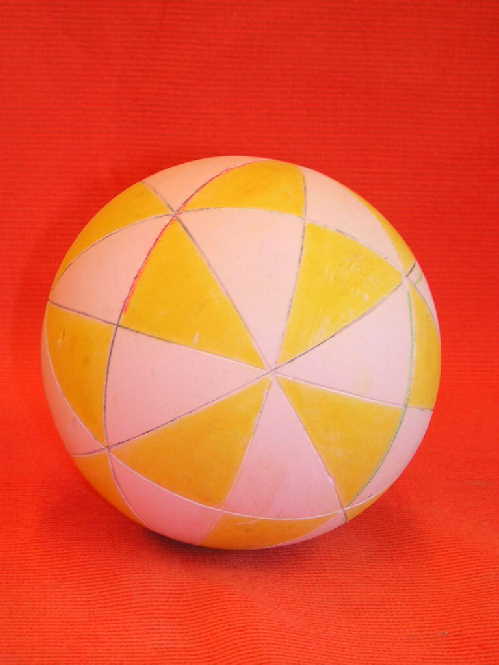
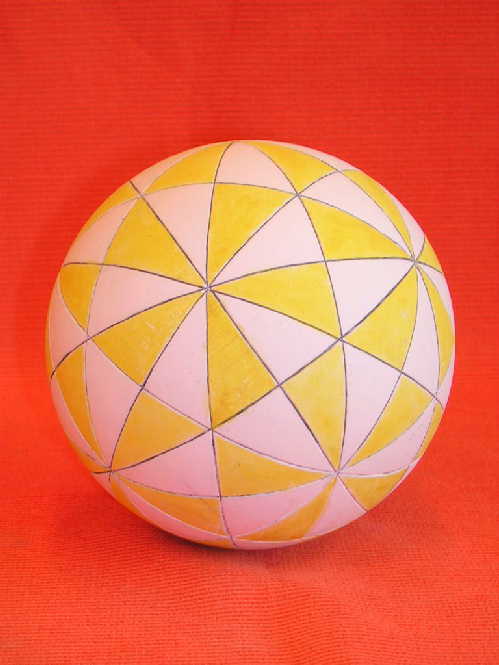

 (Extra
picture for search engine related reasons)
(Extra
picture for search engine related reasons)

 Interestingly, these one-generator tilings are related to exact
solutions to the simplest non-linear differential equation:
Interestingly, these one-generator tilings are related to exact
solutions to the simplest non-linear differential equation:







 : The charges are
discrete! In
nature, the fact that electric charges come in multiples of the
elementary charge seems mysterious, but for complex functions, it is a
necessary consequence from the fact that poles and zero’s
have
integer order!
: The charges are
discrete! In
nature, the fact that electric charges come in multiples of the
elementary charge seems mysterious, but for complex functions, it is a
necessary consequence from the fact that poles and zero’s
have
integer order!











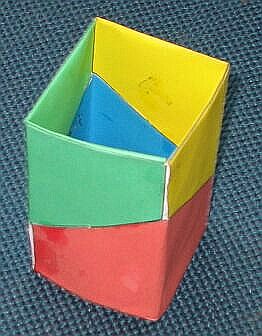
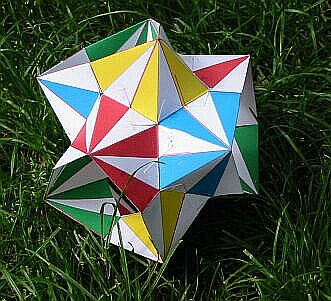
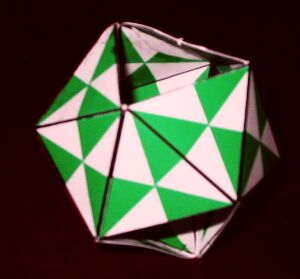
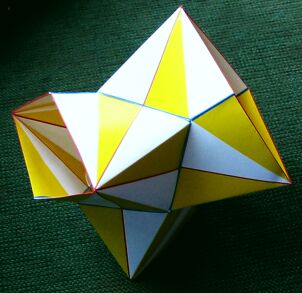
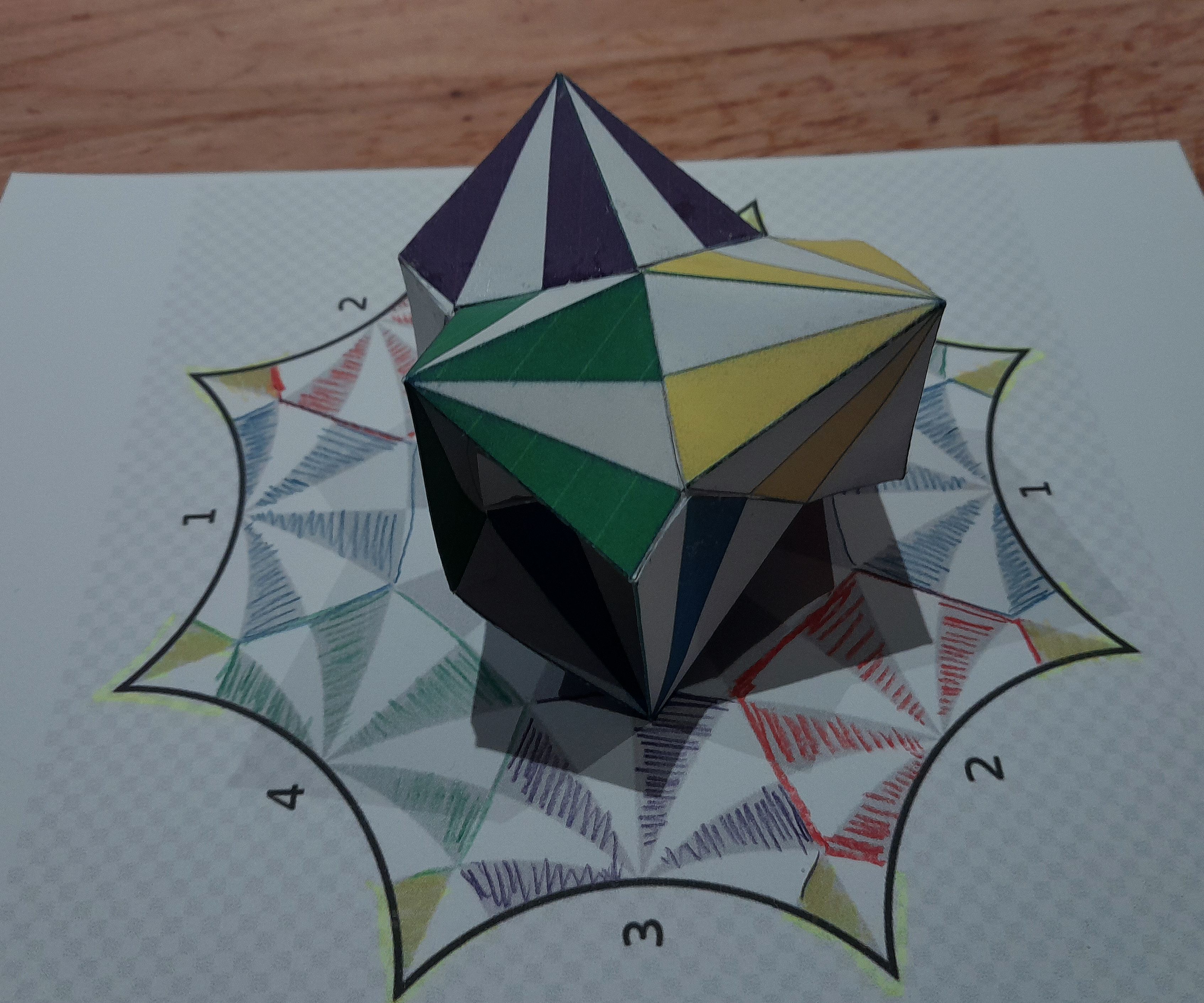
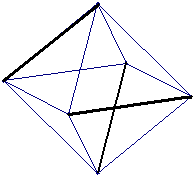
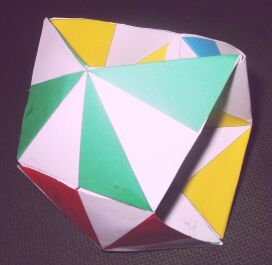
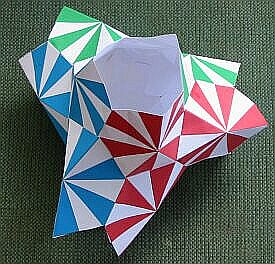
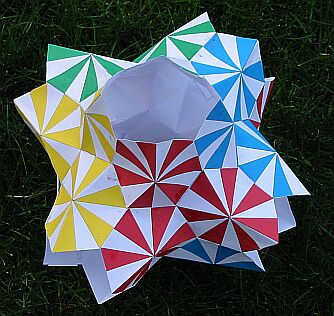
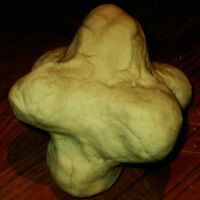
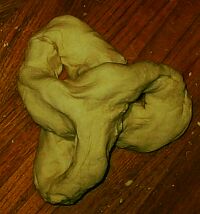
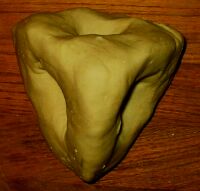


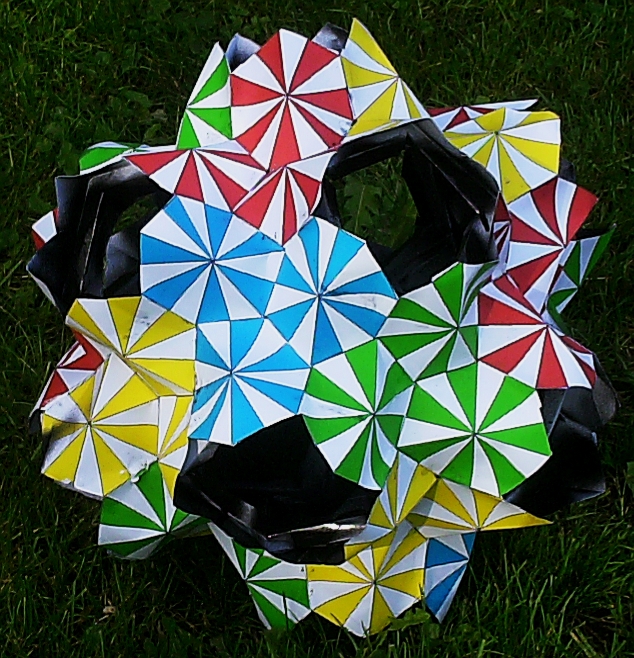
 The
Monster group is also a
Hurwitz surface.
The
Monster group is also a
Hurwitz surface.
 the edge
of each 'hole' forms a knot!
the edge
of each 'hole' forms a knot!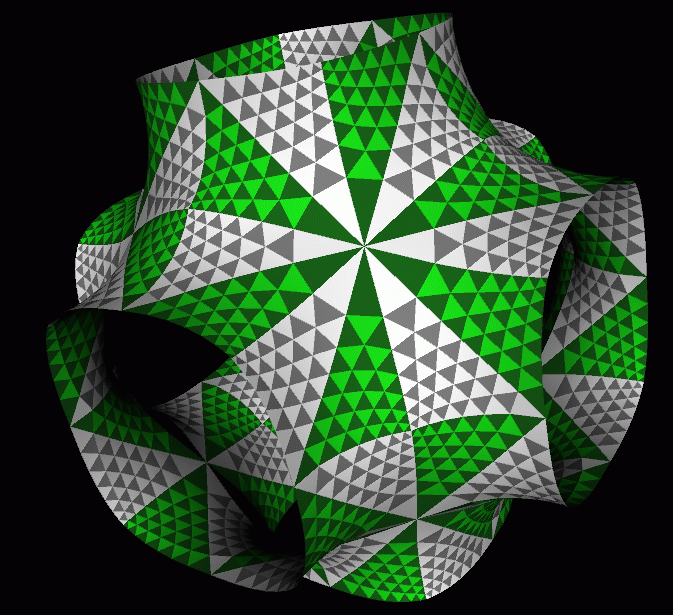
 (Extra picture for search engine related reasons)
(Extra picture for search engine related reasons) constant
Gaussian curvature!
Furthermore, the surface can obviously be
used as an elementary cell in the fashion of infinite polyhedra. In
this
case, (4,6)
infinite polyhedron as well it's
dual (6,4)
infinite polyhedron,
can be seen as a tiling of a
surface formed from units as seen above.
constant
Gaussian curvature!
Furthermore, the surface can obviously be
used as an elementary cell in the fashion of infinite polyhedra. In
this
case, (4,6)
infinite polyhedron as well it's
dual (6,4)
infinite polyhedron,
can be seen as a tiling of a
surface formed from units as seen above.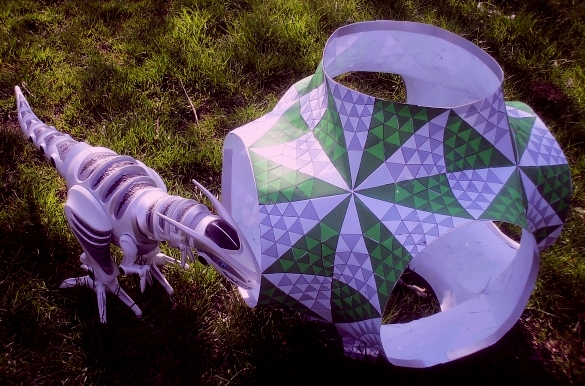
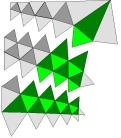
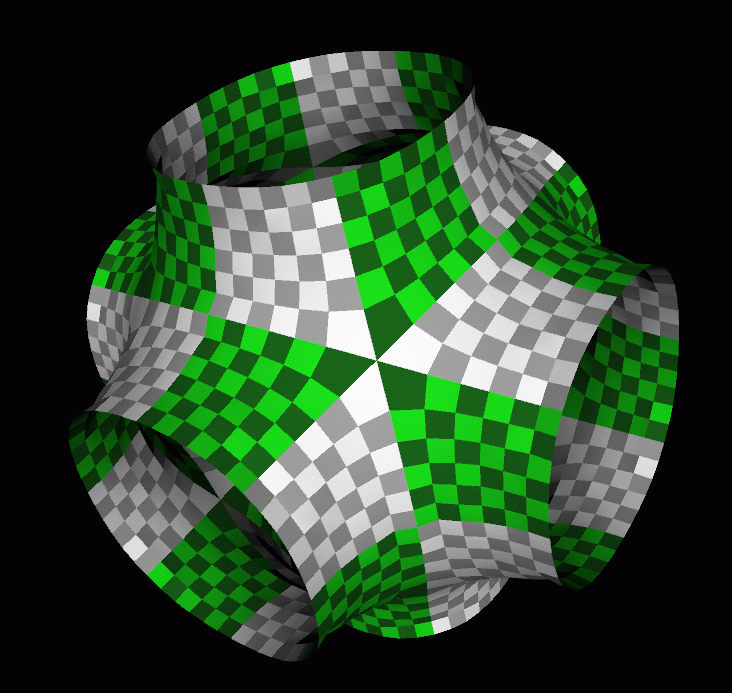
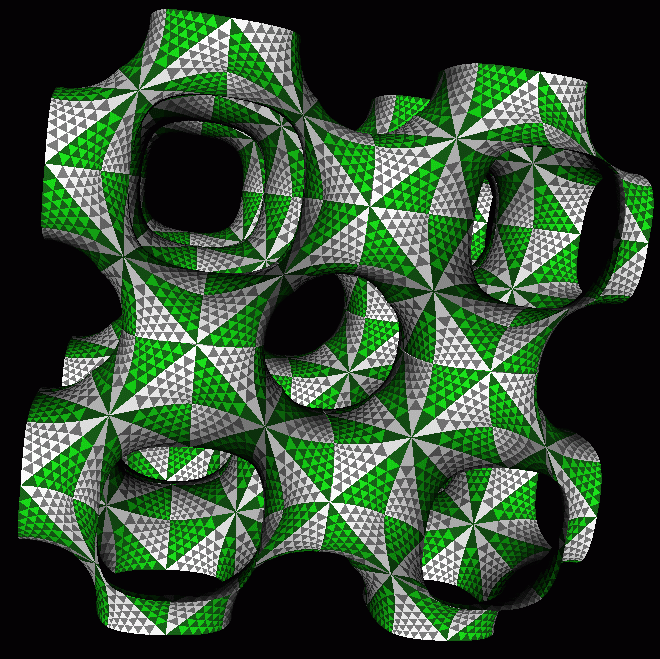
 that the "holes" of the
lattice
are congruent to the lattice itself!
that the "holes" of the
lattice
are congruent to the lattice itself!